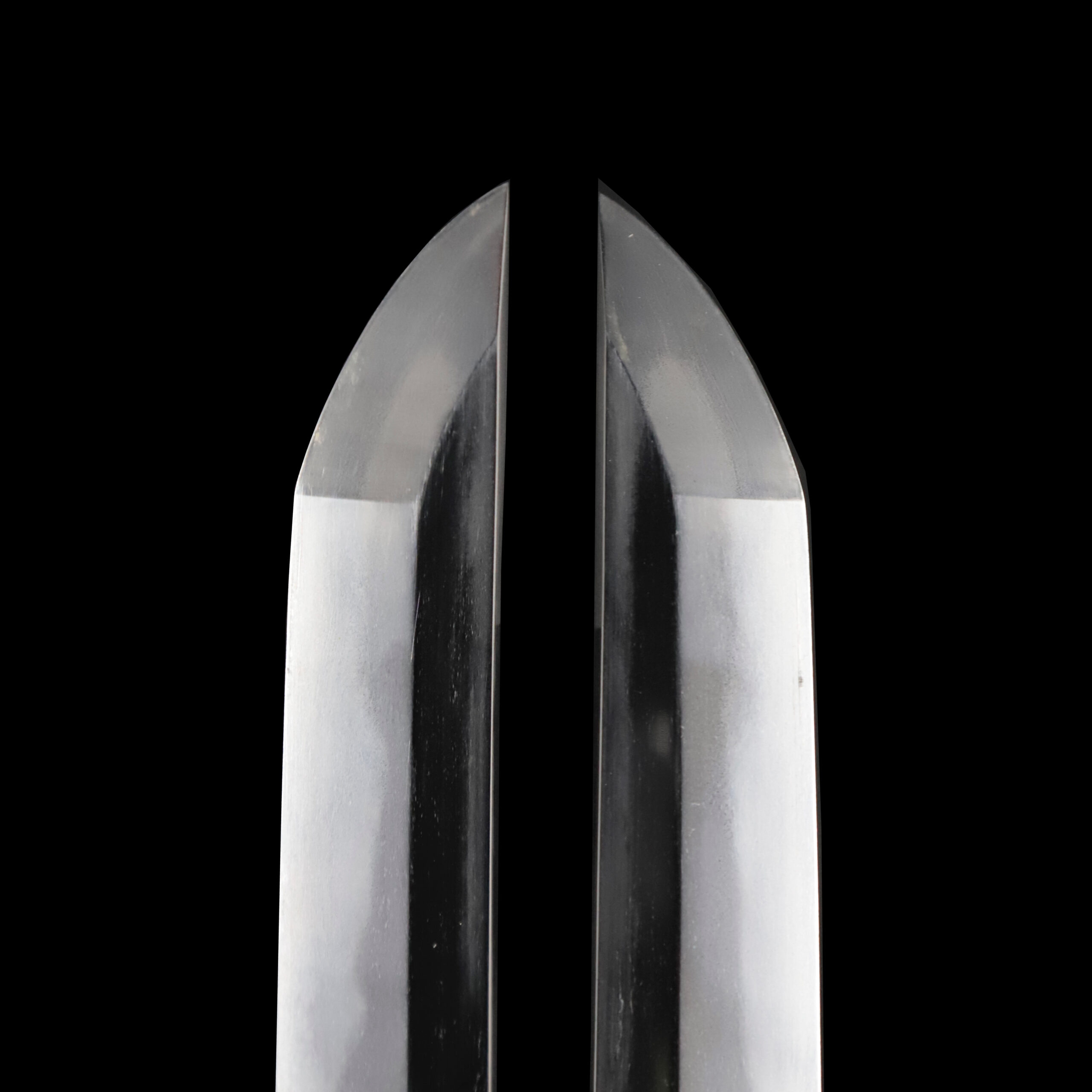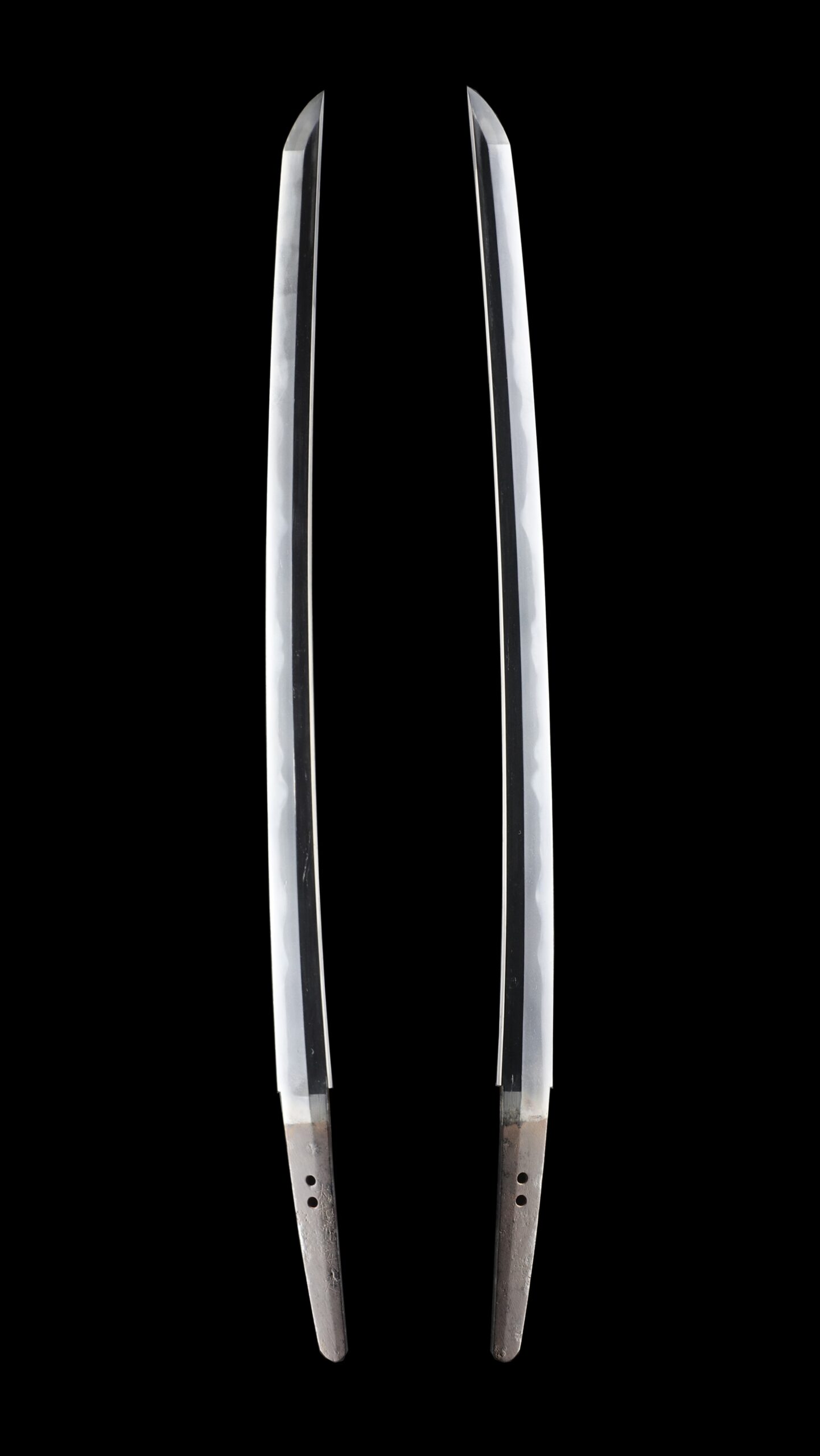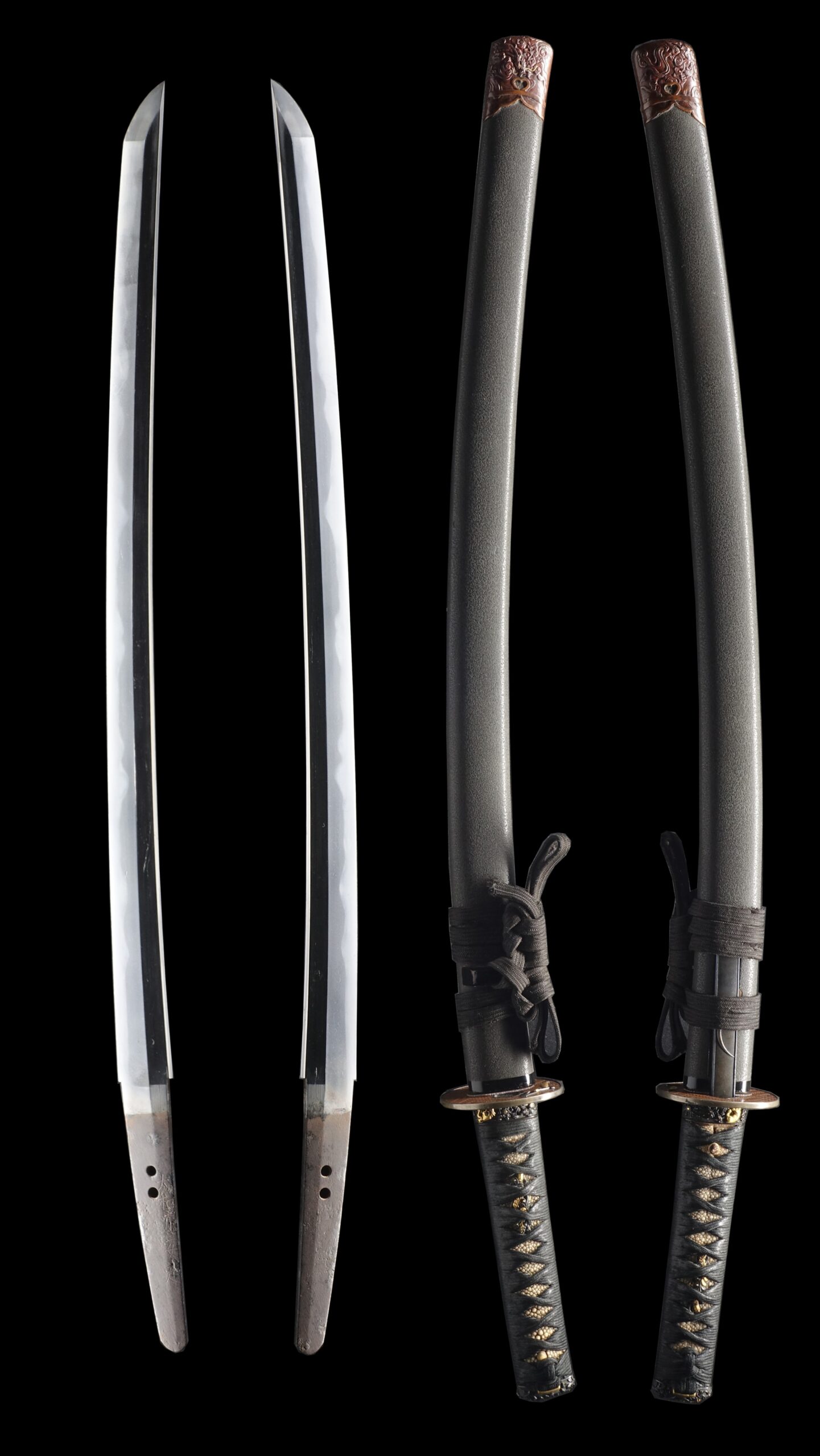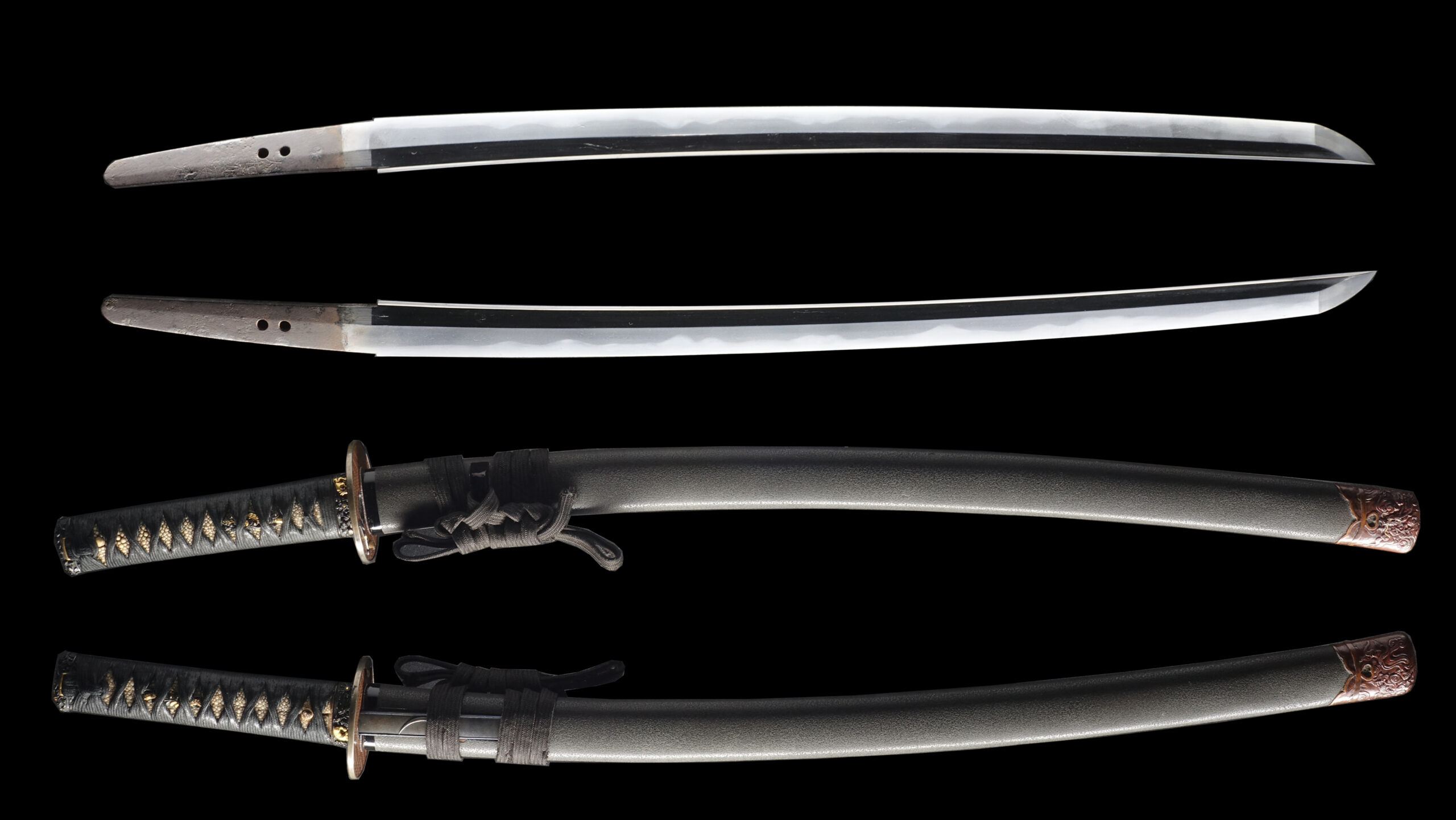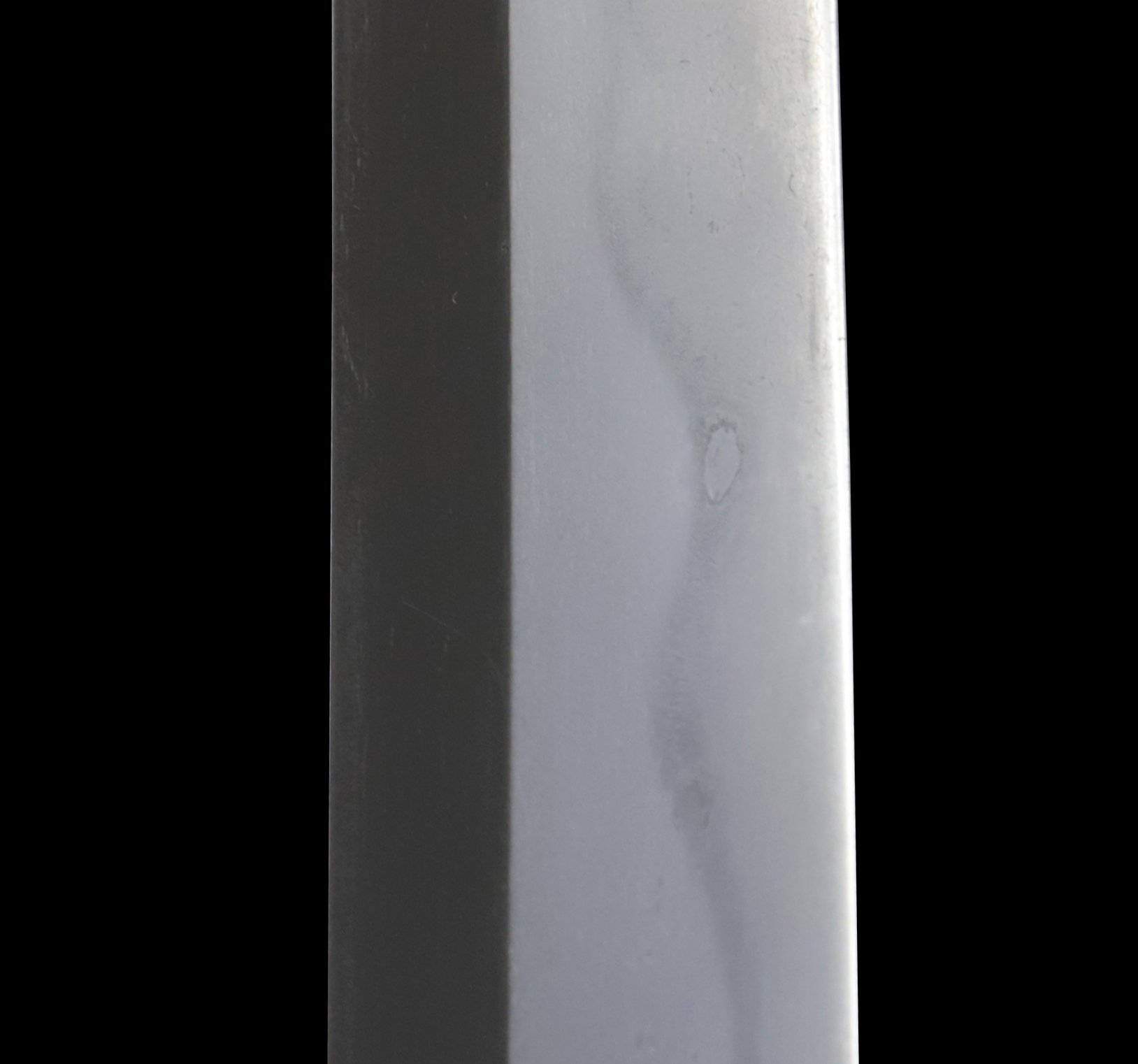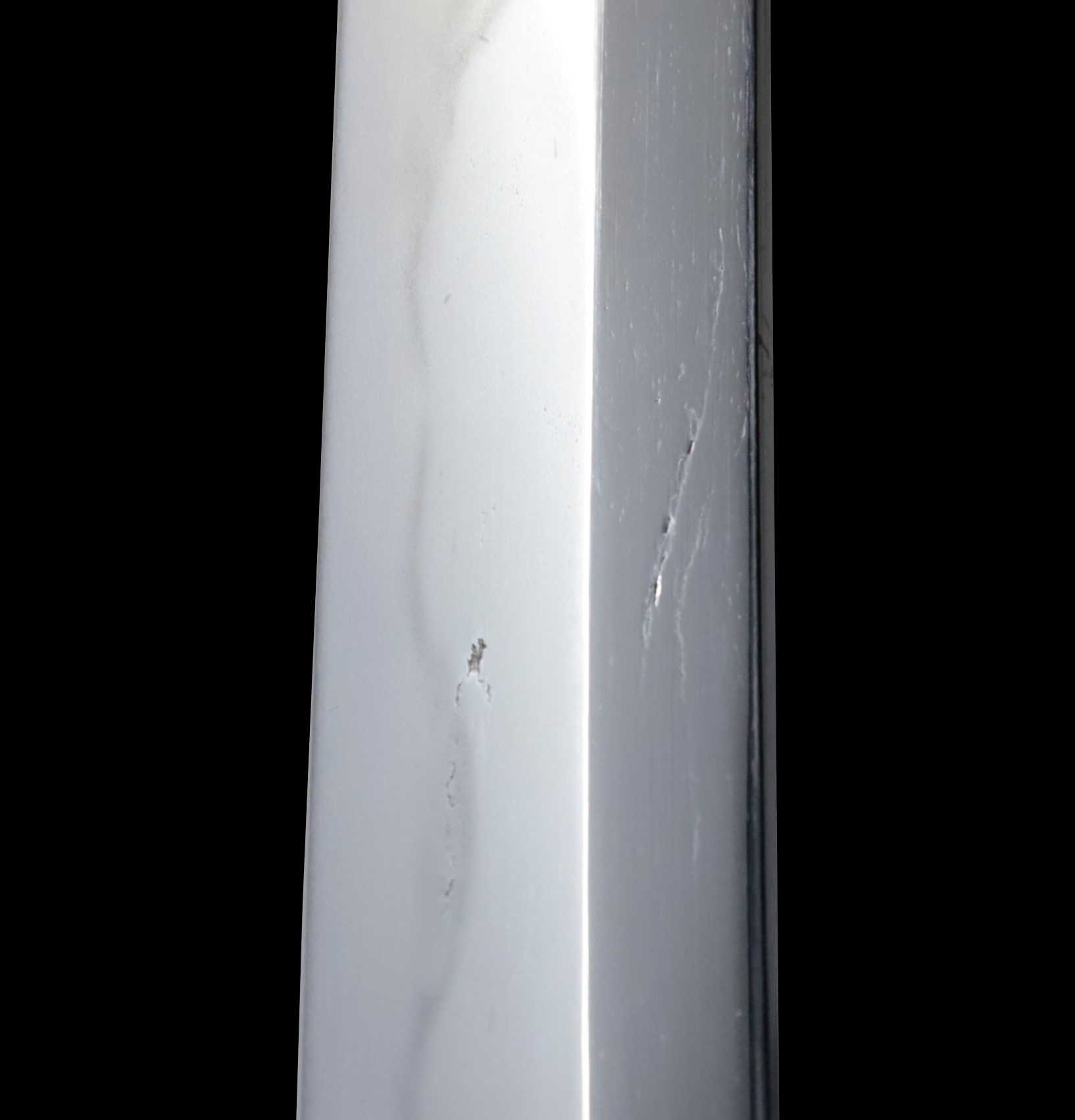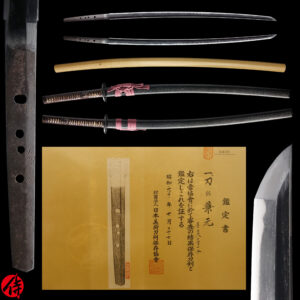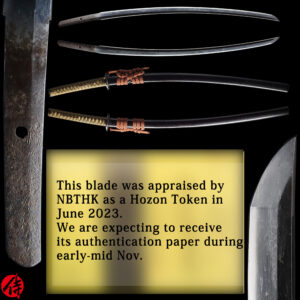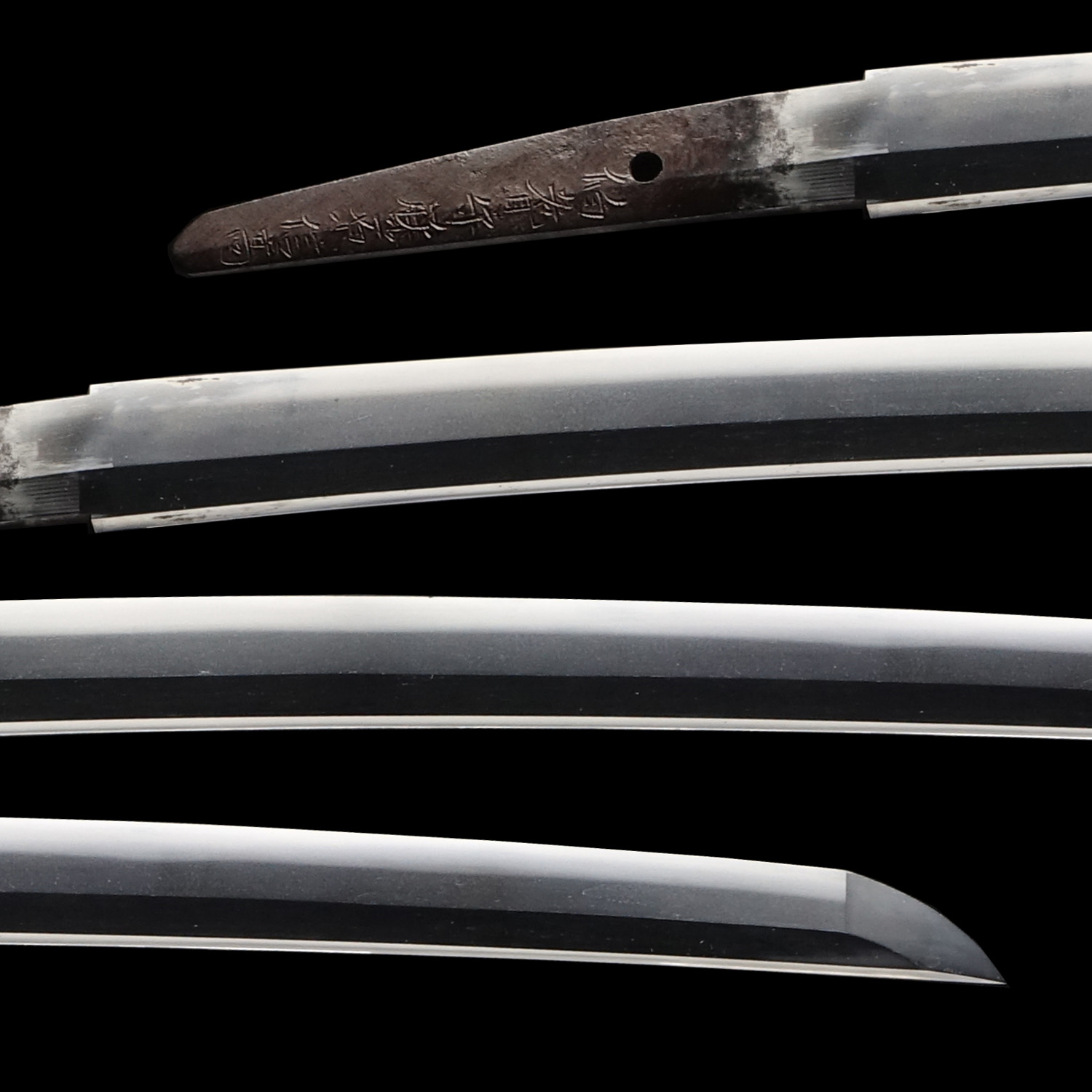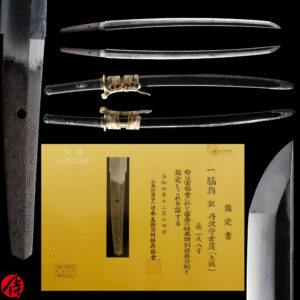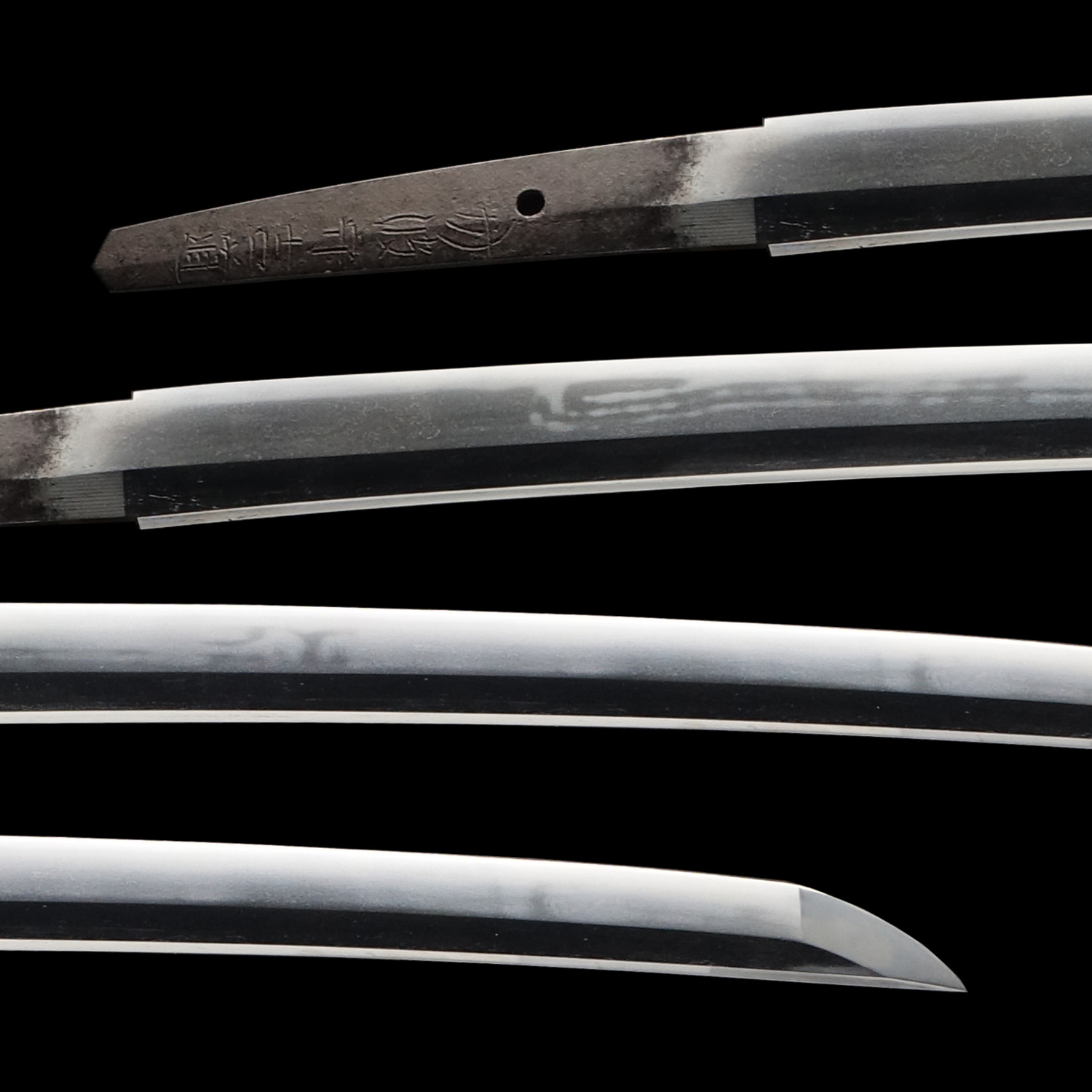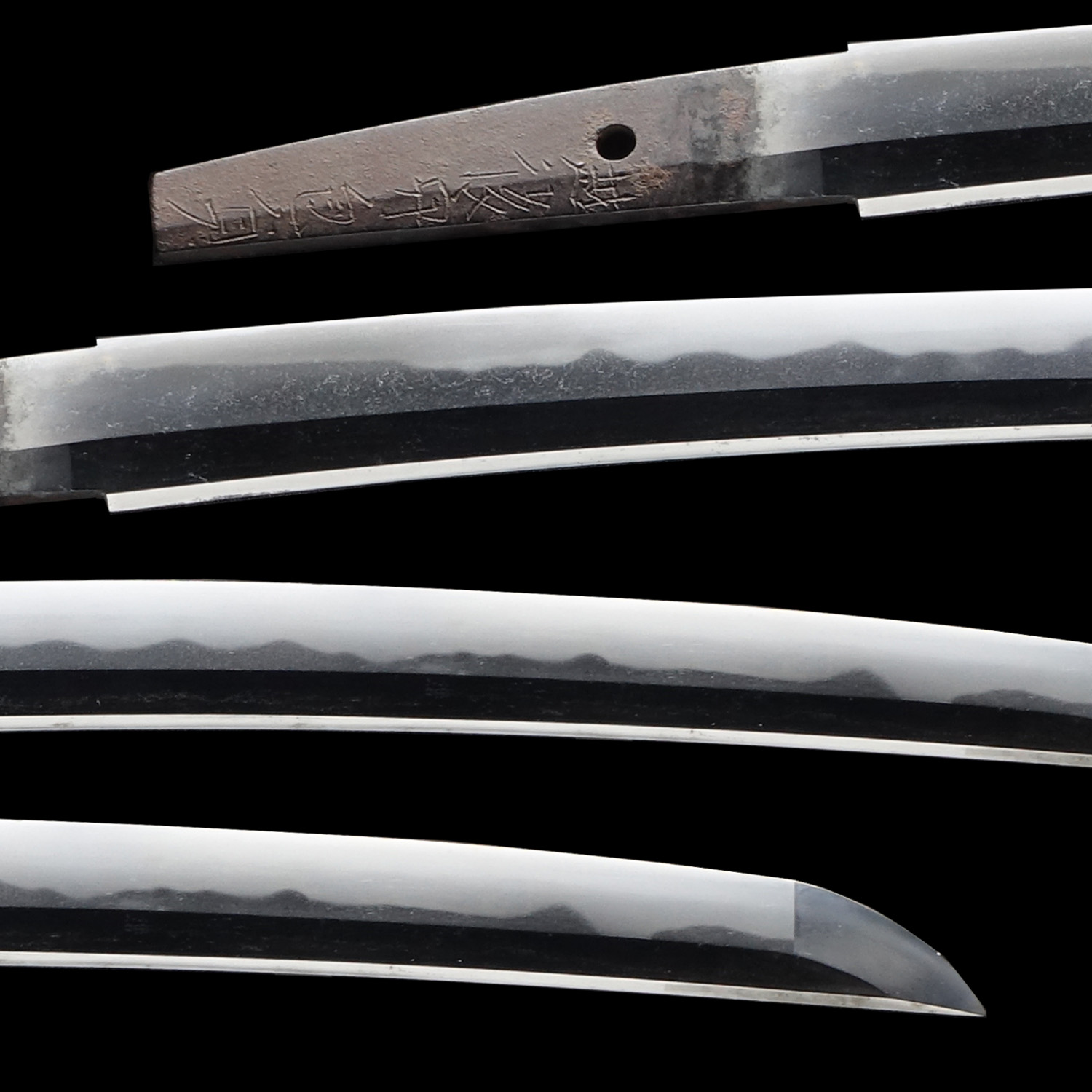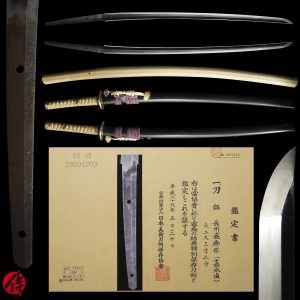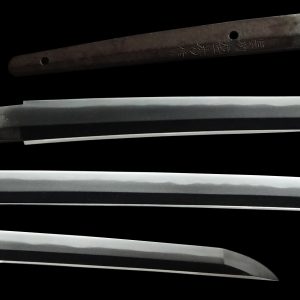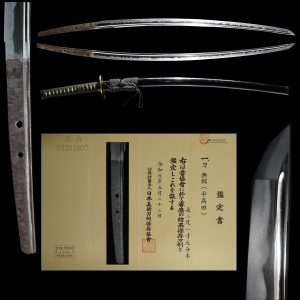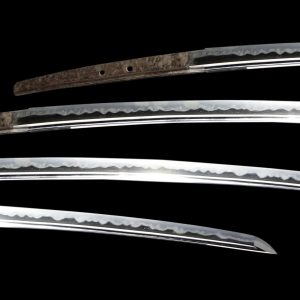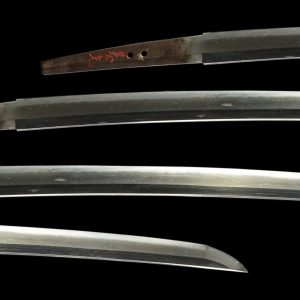Antique Japanese Sword Wakizashi Signed by Yamato no Kami Yasusada with NBTHK Hozon Certificate
【Description】
Summary
This blade was signed by Yamato no Kami Yasusada (大和守安定), who was active during the early Edo period. He is considered one of the top-tier swordsmiths during the early Edo period and he is known for forging extremely sharp blades.
He was born in the 4th year of the Genna era (1618). His birthname was Tonda Soubei (富田宗兵衛). Yasusada originally belonged to Kishu Ishido School, one of the most influential schools during the early Edo period. He first received Yamato Daijo (大和大掾) title when he was in Kishu province, and then he was promoted to Yamato no Kami (大和守).
Daijo or Kami is an official honorable title given by the imperial court for one’s excellent craftsmanship. After spending his early career in Kishu province, he moved to Edo city in 1648 and became an apprentice for Izumi no Kami Kaneshige. Additionally, it is said that Yasusada also learned sword-forging techniques from the third-gen Yasutsugu. Yasusada did Gassaku with the third-gen Yasutsugu as well. Two masters he served were renowned swordsmiths, and he must have learned excellent techniques from them.
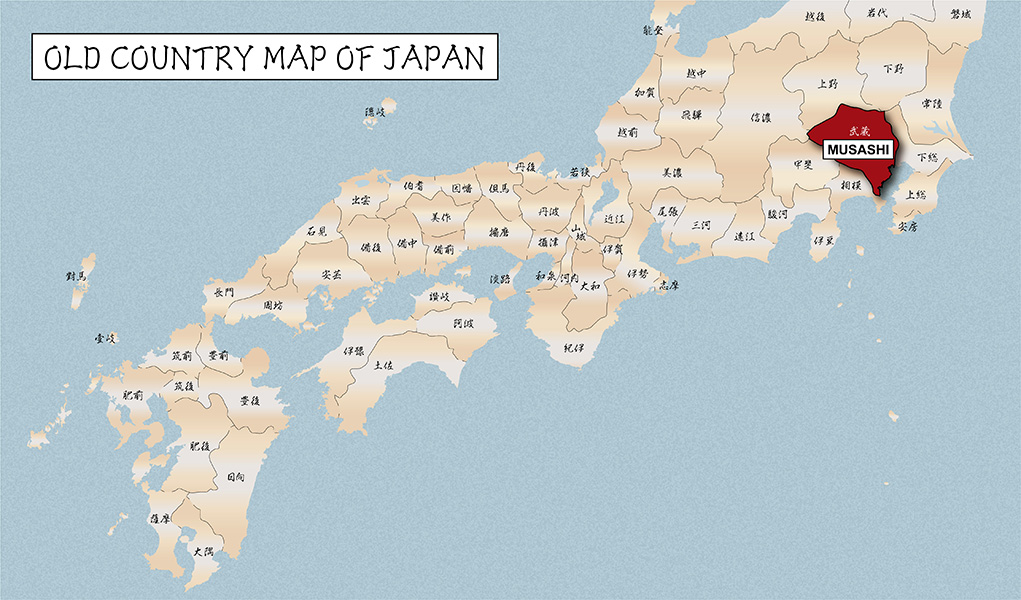
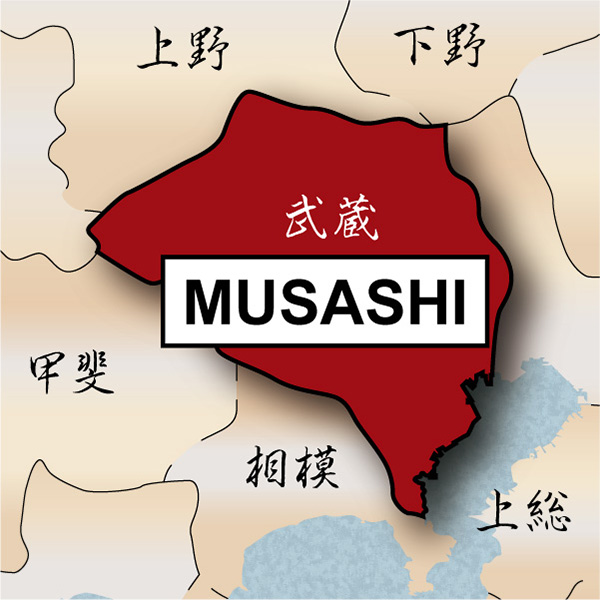
In 1655, Yasusada was invited by the Date clan to Sendai City in Miyagi prefecture. He forged a blade and dedicated it to Sendai Toshogu shrine for Tokugawa Ieyasu’s death anniversary. He also devoted another creation to the Zuihoden mausoleum for Date Masamune’s death anniversary. This fact simply indicates that Yasusada’s craftsmanship was acknowledged and appreciated nationwide, not only in Edo City. He moved to Edo city at around 30 years old, and there was a remaining work made in 1670 when he was 53.
As we explained earlier, his swords have been known for their sharpness. There are many records of his swords passing the test-cutting process (Tameshigiri). In his career, he pursued and researched sword forging to make extremely sharp blades that were practically effective in battles. It is said that Yasusada often received orders from high-class Samurai or feudal lords. According to the book (Kaihou Kenjyaku) published by Yamada Asaemon in the late Edo period, a blade forged by Yasusada was ranked as Yoki wazamono (excellent sharpness). The Edo government hired Asaemon as an expert on Tameshigiri, or testing cutting. In this book, he judged how sharp Japanese swords forged by prestigious swordsmiths were.
At the end of the Edo period, Yasusada’s fame became at another level because a few members of Shinsengumi owned blades made by Yamato no Kami Yasusada, including Okita Soji and Saito Hajime. They love Yasusada’s work for its sharpness and craftsmanship.
Ishido School
Ishido school was initially founded by Sukenaga, an offspring of Ichimonji Sukemune, who had created Fukuoka Ichimonji school in Bizen province (Today’s Okayama prefecture).
During 1492-1501 (Mid Muromachi period), Sukenaga and his school moved from Bizen province to Omi province after being summoned by Gamou family, a powerful feudal line in that region. Sukenaga started to live in front of Ishido temple, and he changed his surname to Ishido.
As of the early Edo period, many Ishido swordsmiths in Omi province moved to other parts of Japan. Four major branches flourished in Edo, Osaka, Kishu (Wakayama prefecture), and Chikuzen (Fukuoka prefecture). Following this trend, Yasuhiro, a prominent figure in Omi Ishido school, moved to Kishu province from Omi province. It is said that Yasuhiro was the founder of Kishu Ishido school. There is a record where Yasuhiro and Yasusada forged a blade together. When two swordsmiths collaborate to create one work, it is called Gassaku (合作). It was generally done by a master and his apprentice or his son. This fact indicates that Yasusada had a close tie with the head of Kishu Ishido school.
This blade is appraised as a Hozon Token (保存刀剣) issued by NBTHK(Nihon Bijutsu Touken Hozon Kyokai:日本美術刀剣保存協会). This authentication paper was only given to authentic Japanese swords, well preserved and high quality with artistic value.
*Please keep in mind that there are a couple of Kitae Kizu on this blade. If you like to know the detailed condition, please feel free to contact us.
【Blade】
Cutting Edge Length(Nagasa): 52.2 cm (20.5 inches)
Curvature(Sori):1.0 cm (0.39 inches)

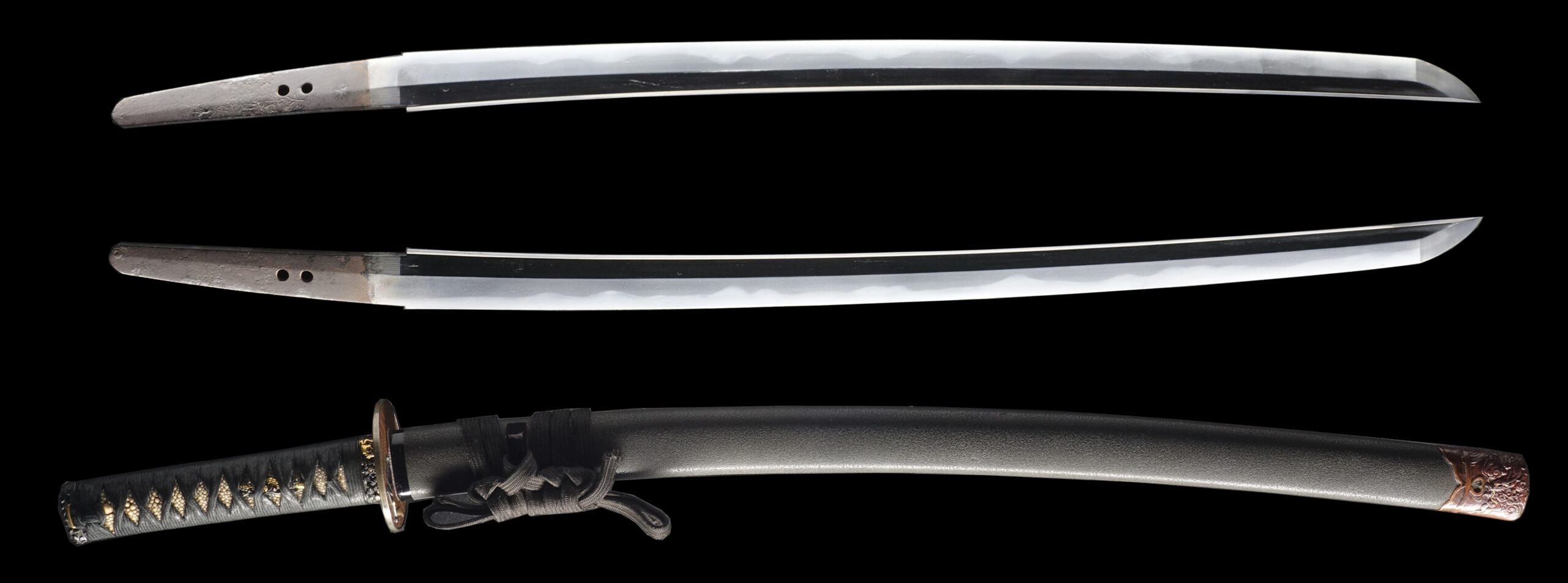
Hamon:
The crystalline structure which forms along the cutting edge of a blade as a result of the hardening process
Jimon(Jihada):
visible steel surface pattern created by folding and hammering during forging process
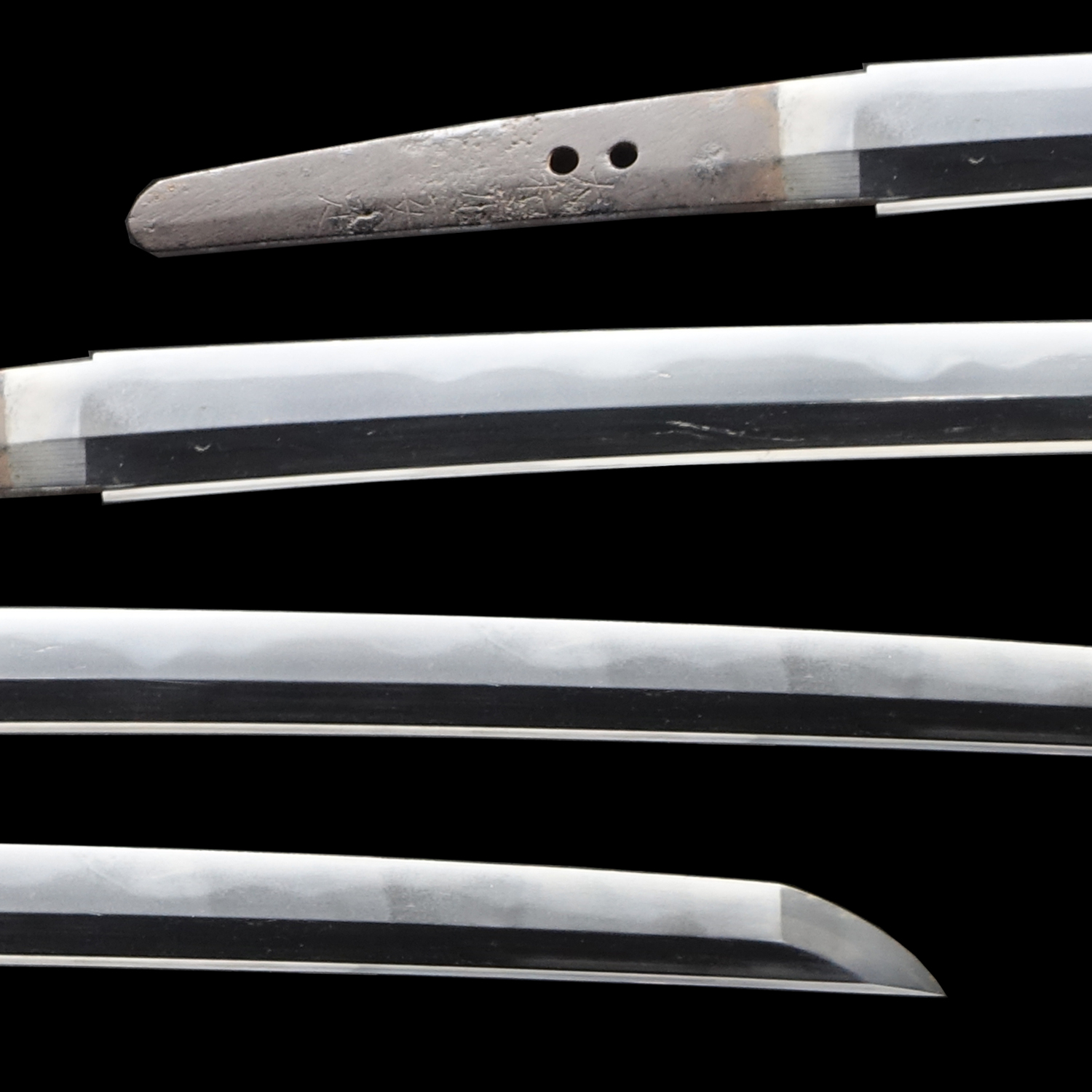
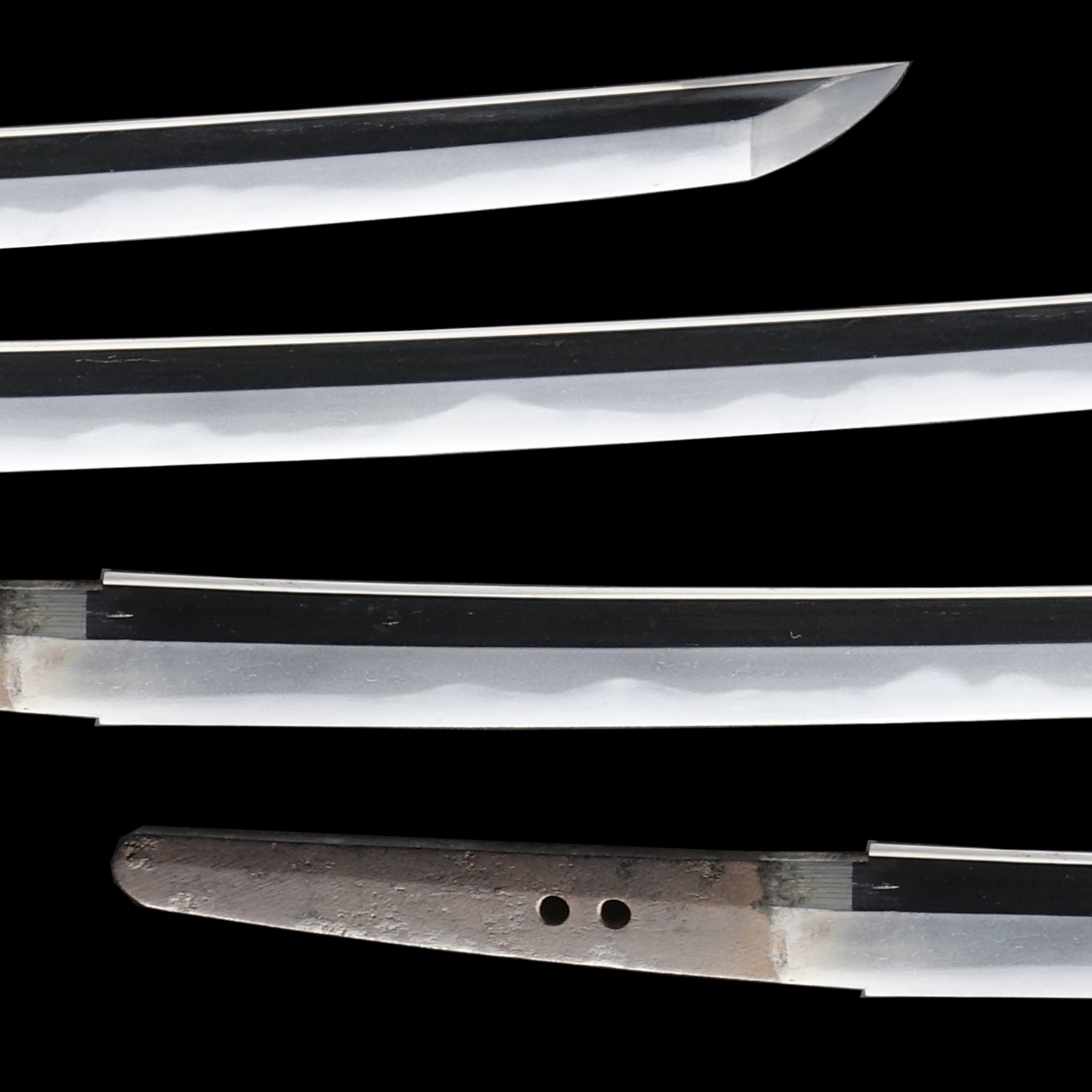
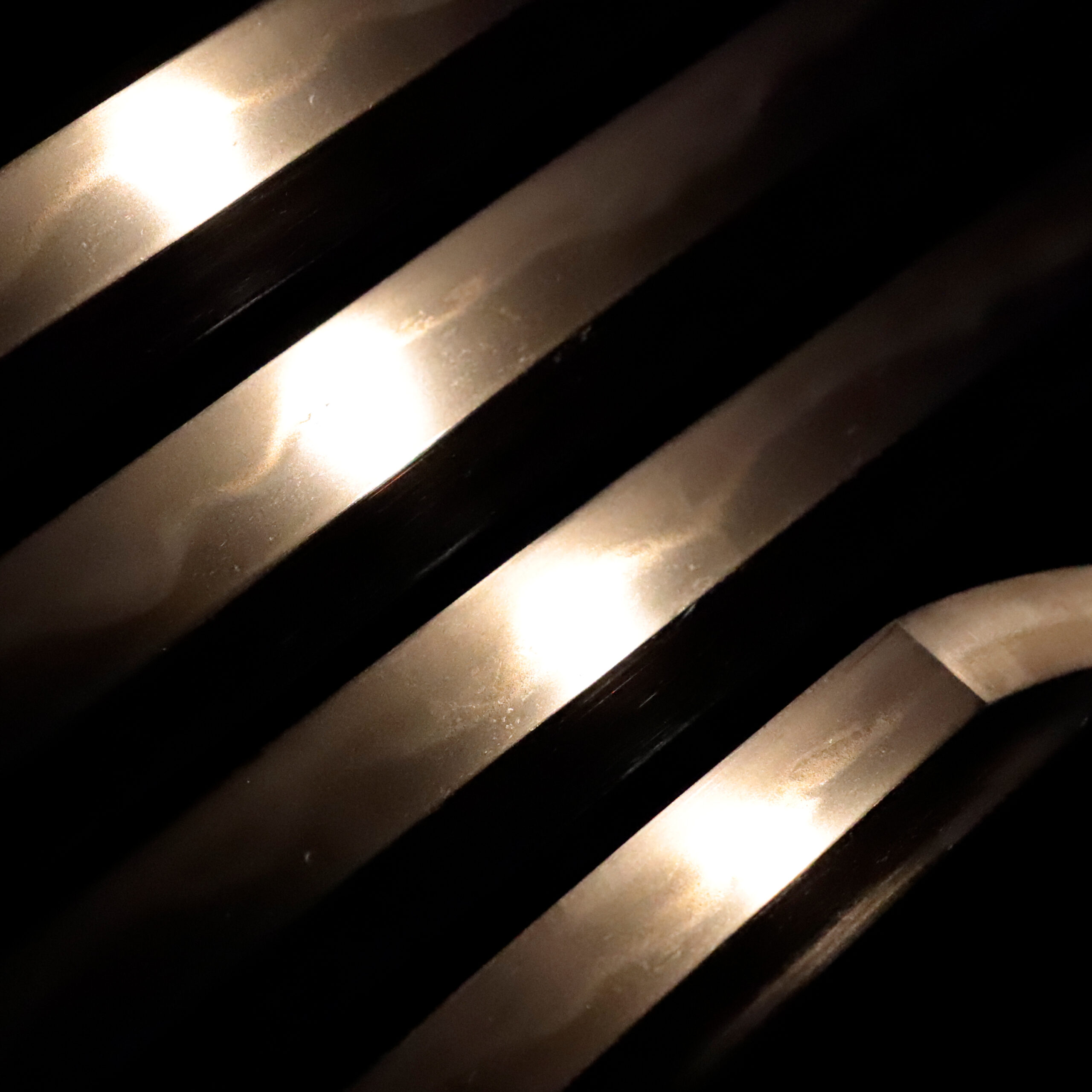
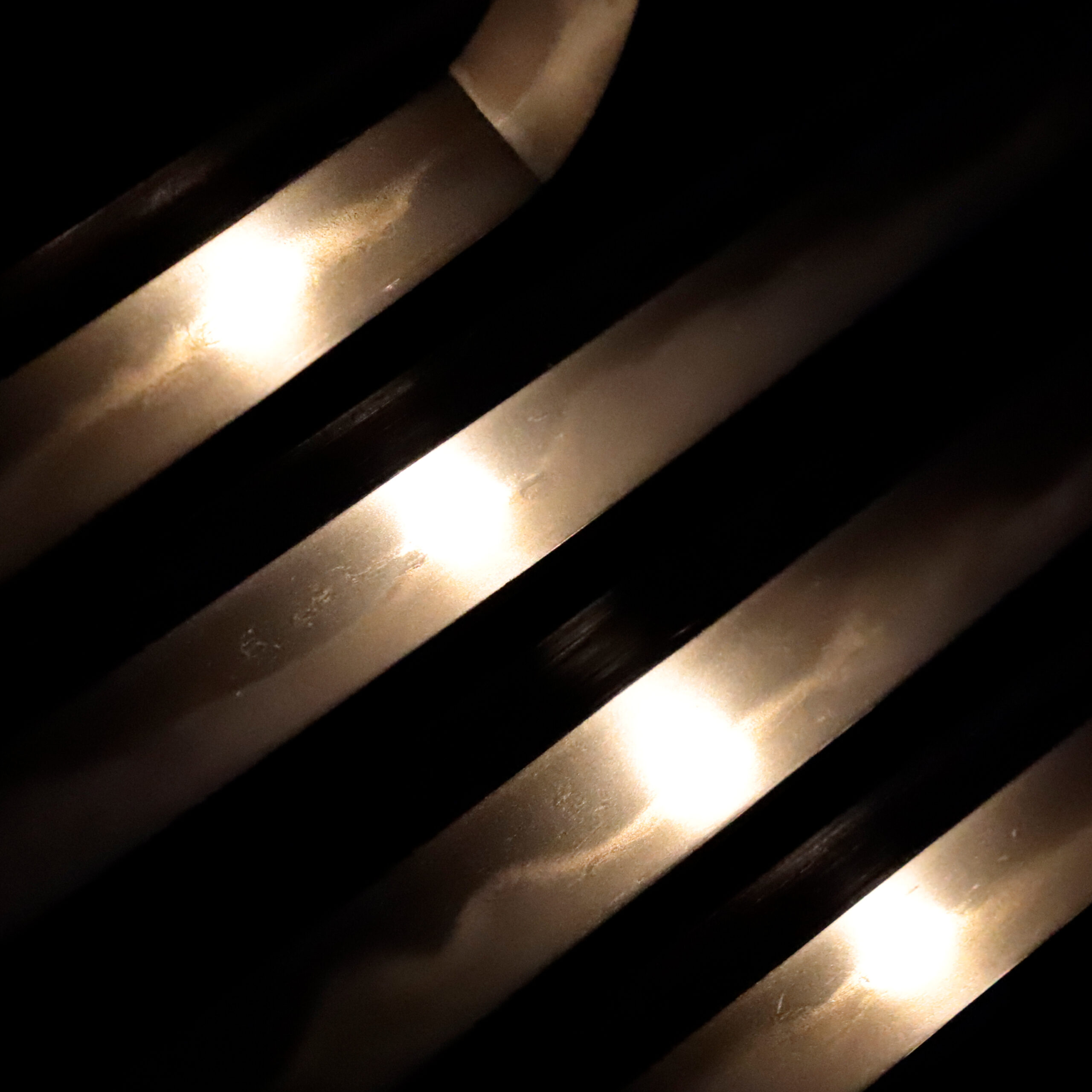
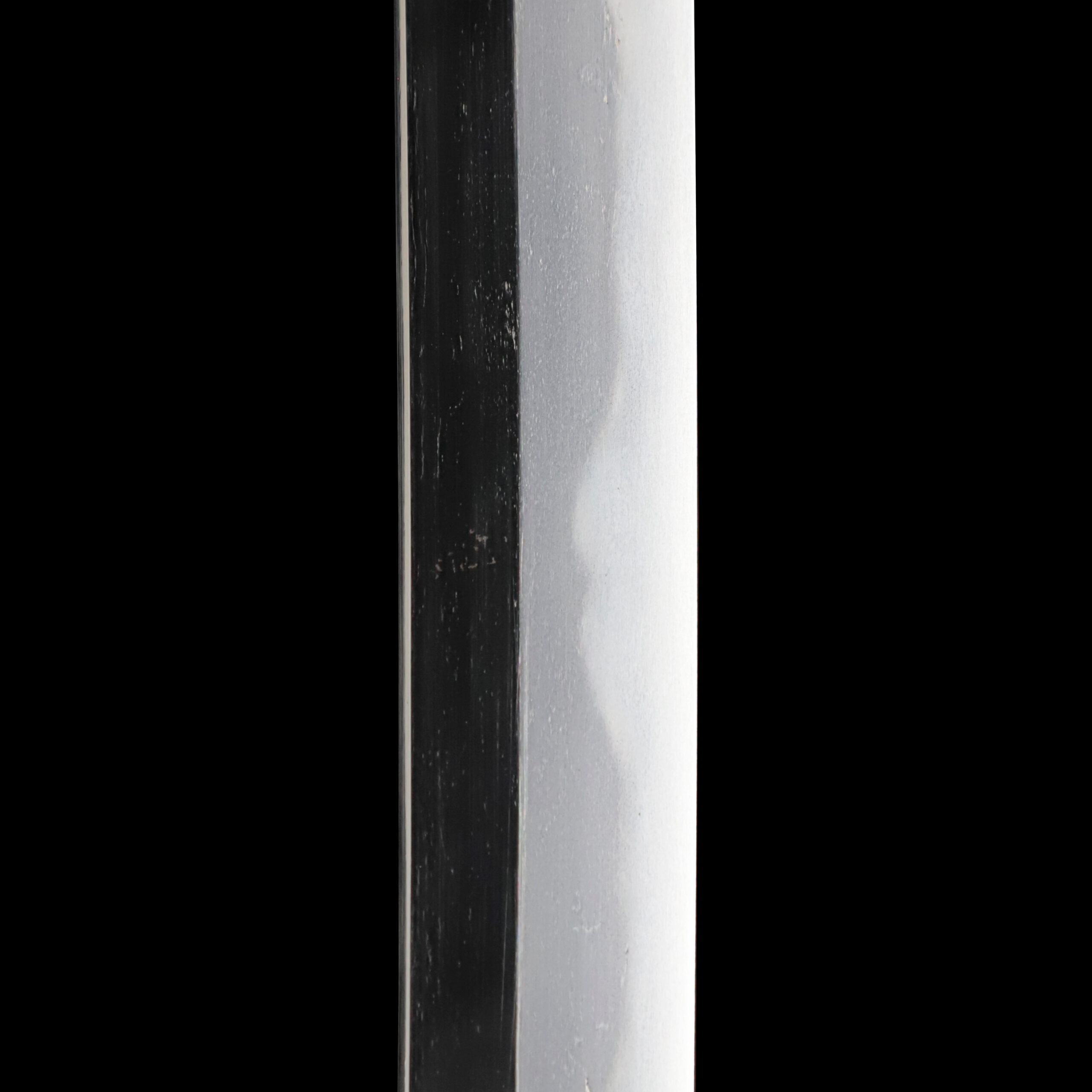
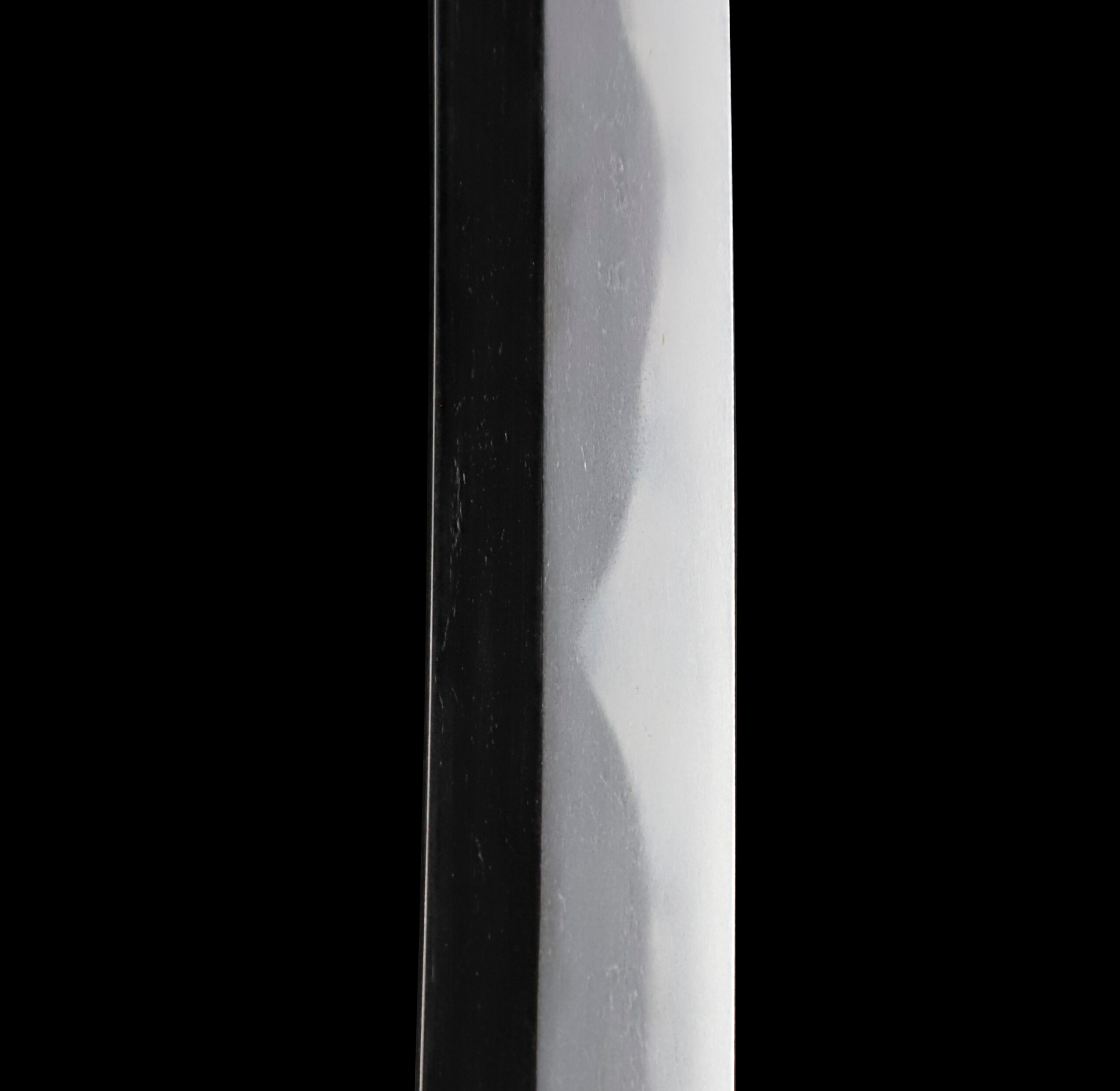
Kissaki:Kissaki is the tip of the Japanese sword.
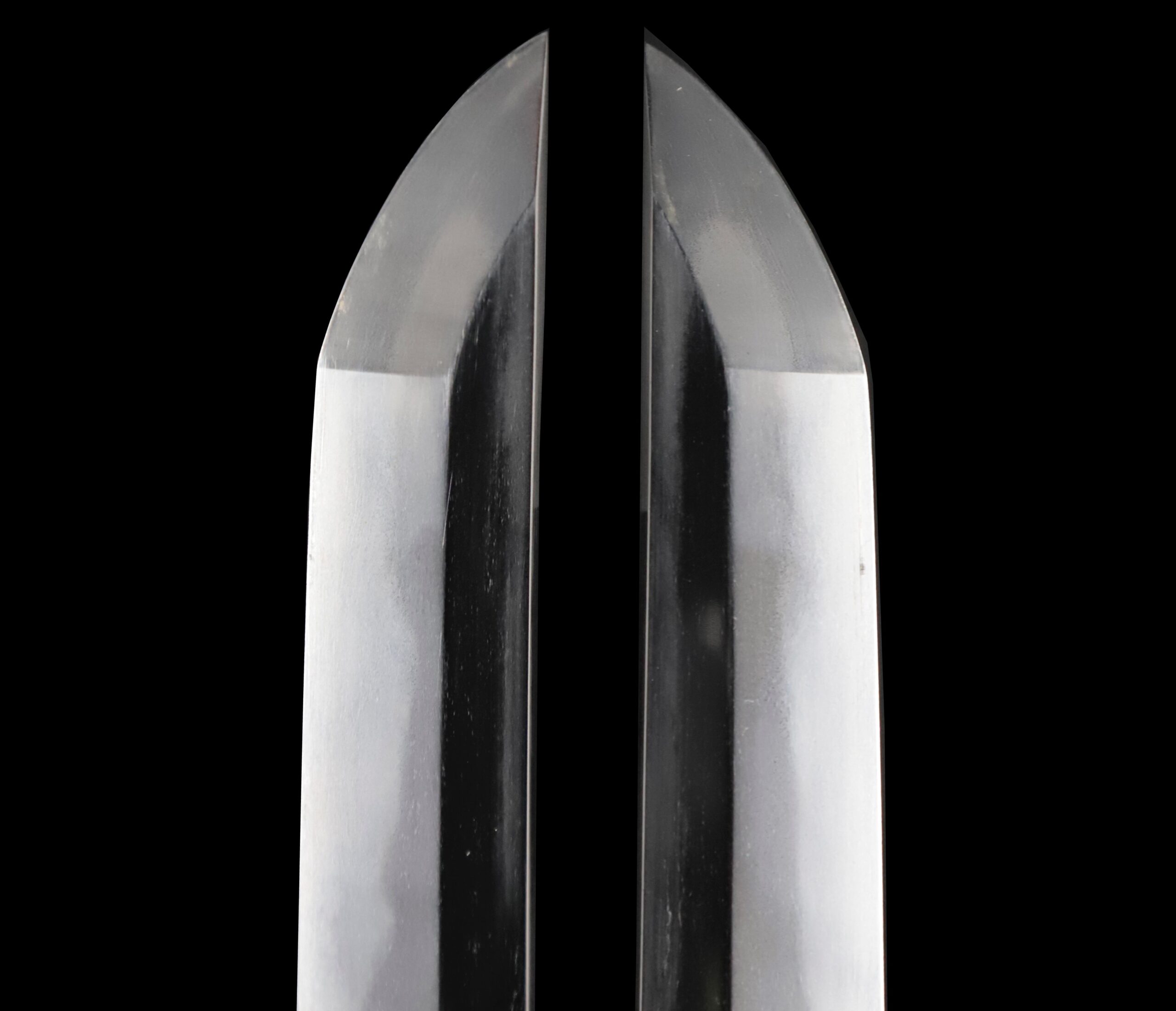
Nakago:Nakago is the tang of the Japanese sword.
Japanese swordsmiths left the black rust on the tang because it prevents red rust while the tang is in its handle. And the discoloration of the tang was created over time, and it is a great indicator for a Japanese sword specialist to estimate when the sword was forged.
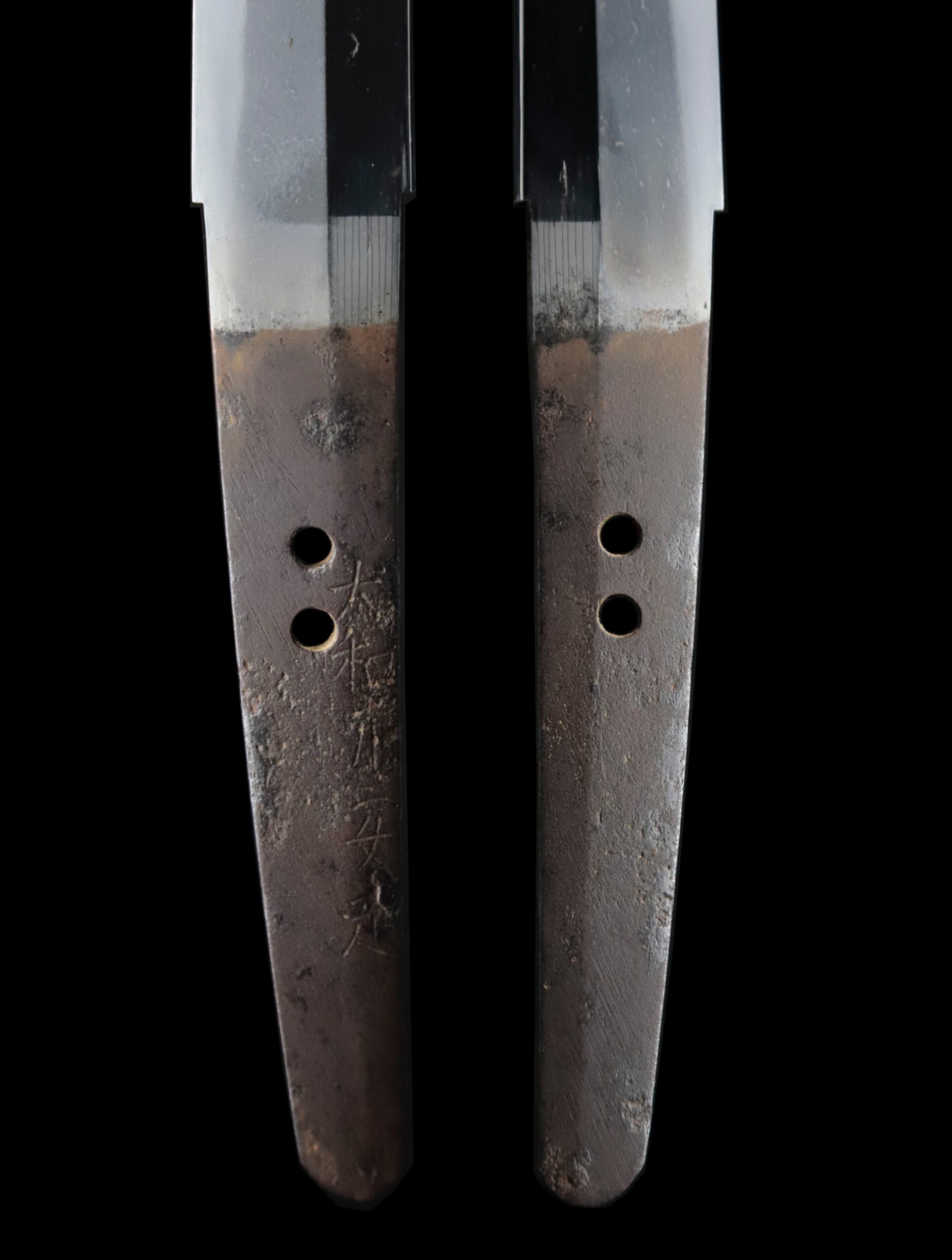
Koshirae:Koshirae is the mounting of the Japanese sword. There are several parts that consist of Koshirae such as Saya (Scabbard), Tsuka (Handle), Tsuba (Handguard).
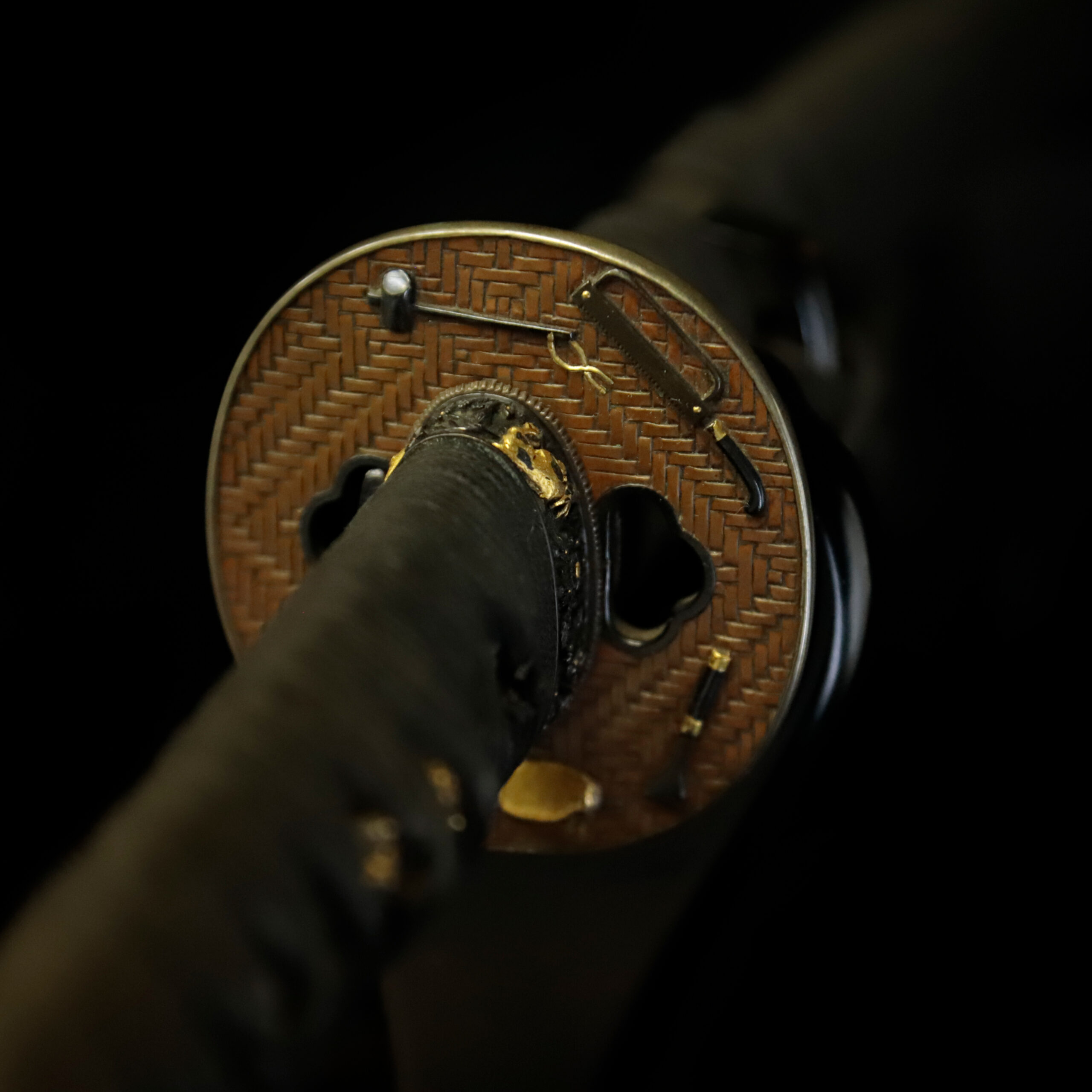
Fuchi-Kashira:A pair of matching sword fittings that cover the upper and bottom parts of its sword hilt.
The deer (鹿:Shika) and the chrysanthemum (菊:Kiku) are depicted on this Fuchi Kashira. You would find two deers in the plants. One deer which has golden body is standing and the other one is sitting near the chrysanthemum. People once thought deer were gods’ vehicles, so that this animal represents longevity.
The chrysanthemum was used as a medicine for obtaining a long life in China a long ago, and it was brought to Japan with this thought in the Nara period (648-781). It is one of the flowers which symbolizes fall, and people appreciate it very much since ancient times. As its petals form radially, the chrysanthemum has been likened to the sun. That is why this flower pattern is treated as the symbol of perpetual youth and longevity or good health. “Kiku no Gomon (菊の御紋)” is a kind of chrysanthemum pattern, and it has been used as the crest of the Emperor and the royal family in Japan so that it is well-known as a noble pattern.
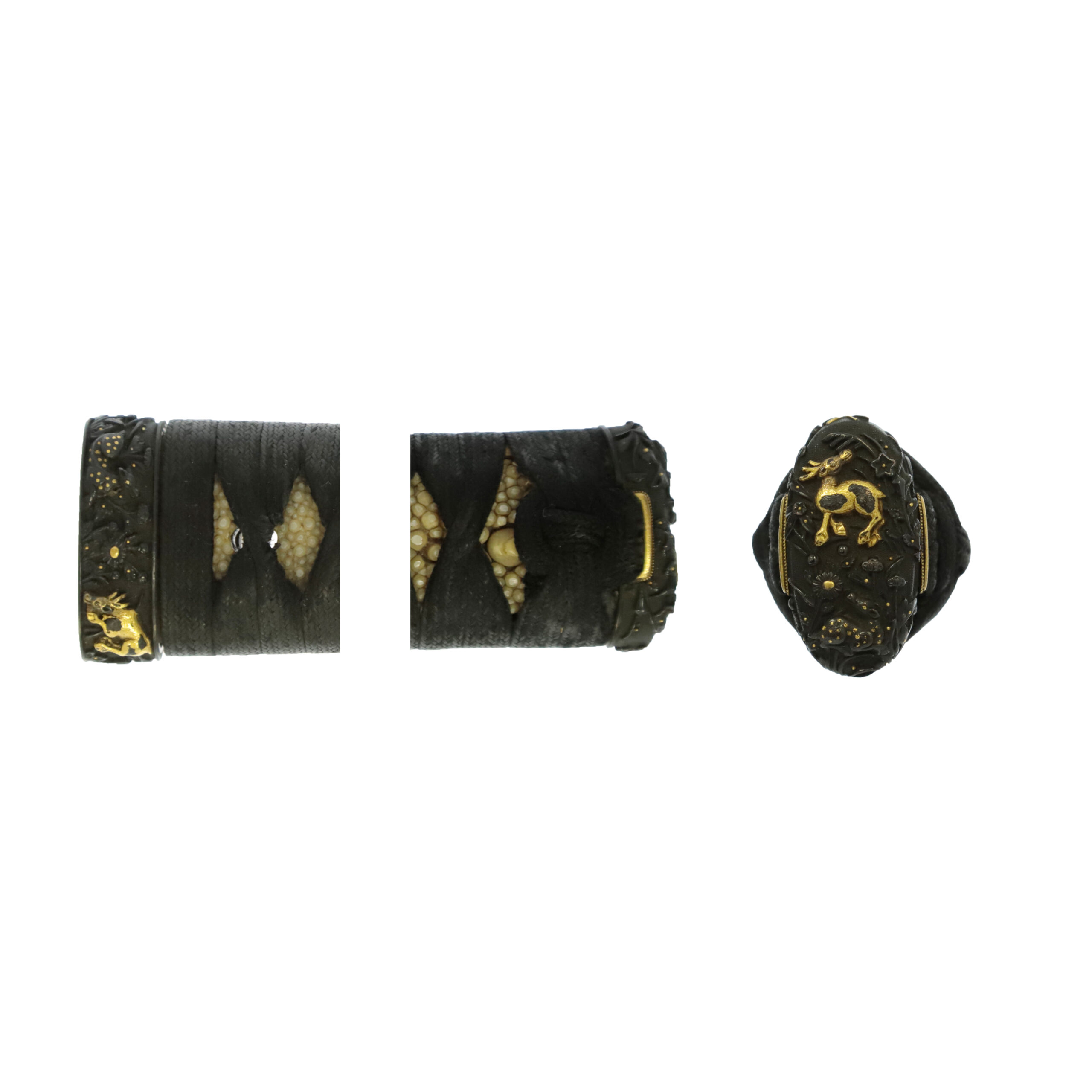
Tsuka and Menuki:Tsuka is the handle of the Japanese sword and Menuki is its decoration.
We assume the motif of this Menuki is the Inaho (稲穂: ears of rice). Since ancient times, rice has been worshiped as an essential food and considered a symbol of wealth. In addition, it has been treated like a treasure. Some people believe that god dwells in it. Therefore, the Inaho pattern has often been designed as a crest of the Inari (稲荷) shrine, which enshrines the Inari god, who is regarded as the god of grain and agriculture. Also, this plant motif is seen for family crests. It is one of the familiar designs for Japanese people. This design might have had chosen in the hope of a plentiful harvest and a prosperous life.
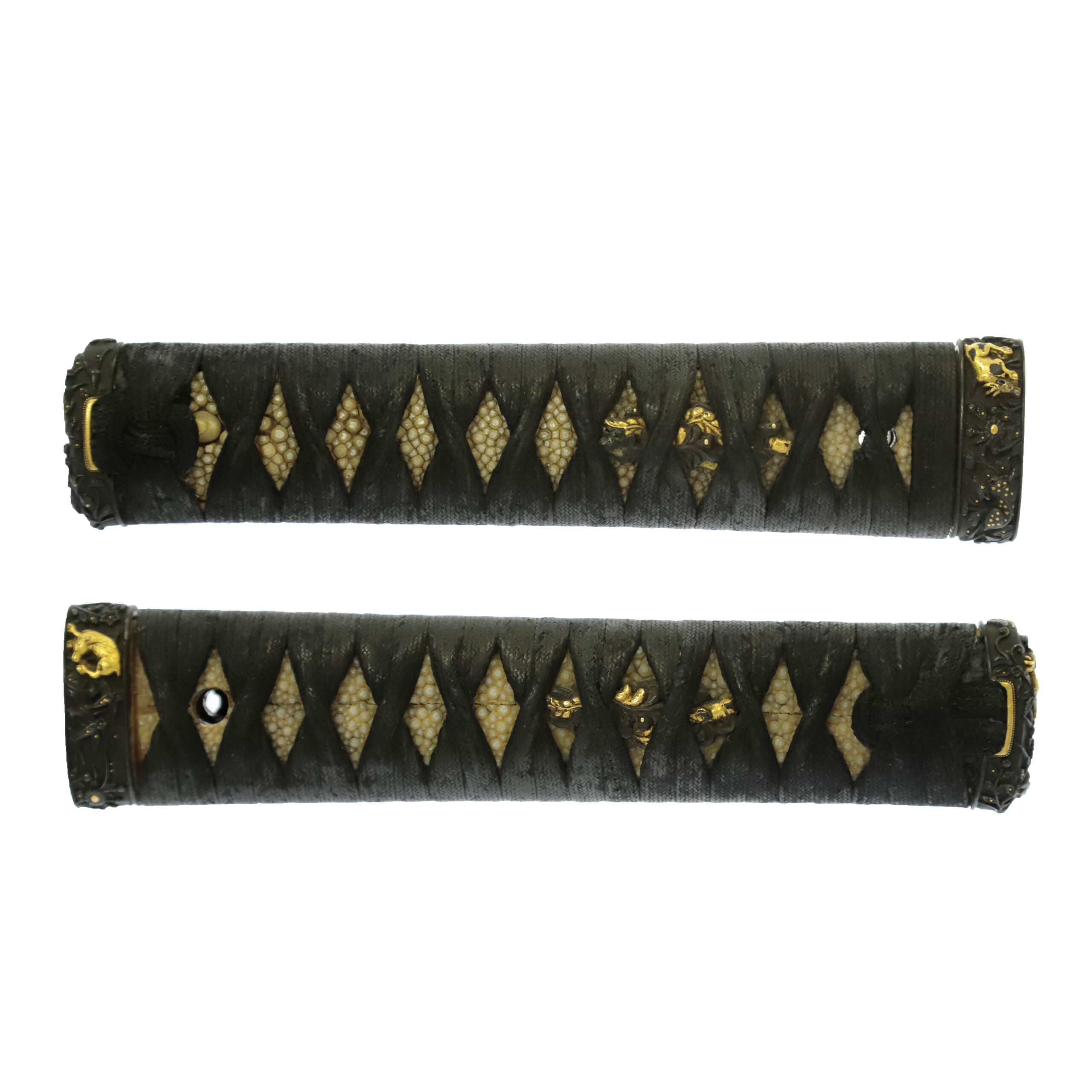

Tsuba and Habaki:Tsuba is the handguard for the Japanese Sword and Habaki is the equipment to make the blade not touch its scabbard inside. It prevents the blade from getting rusty and chipped.
We assume the motifs depicted on this Tsuba are tools for building houses. In the Edo period, people lived in traditional Japanese wooden houses. These tools were thought to be used to build houses by carpenters at that time.
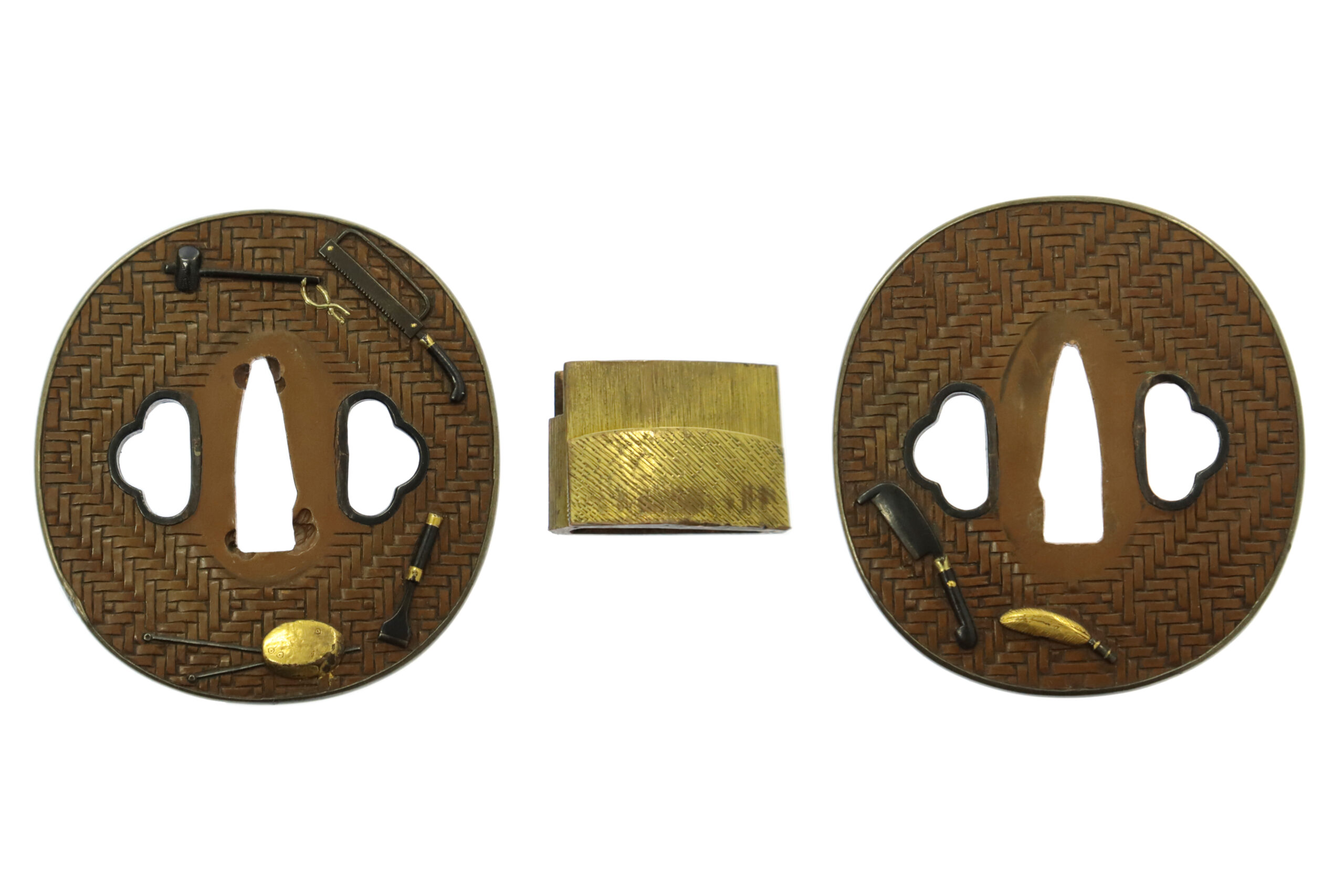
Kozuka:Kozuka is a small knife stored in Kozuka Hitsu(groove of the sheath of the Japanese sword).
The motif of this Kozuka is the moon (月: Tsuki). The sun and the moon have been treated as objects of worship since ancient times. Some people considered them the symbol of authority. The moon pattern has various shapes depending on the waxing and waning of the moon: full moon, half-moon, crescent, or hazy moon. There is also the idea: as the moon changes its shape depending on its fullness, it represents growth and development. Moreover, the moon is a classic design that symbolizes autumn: the combination of a moon with rabbits, deer, autumn grass, waves, etcetera.
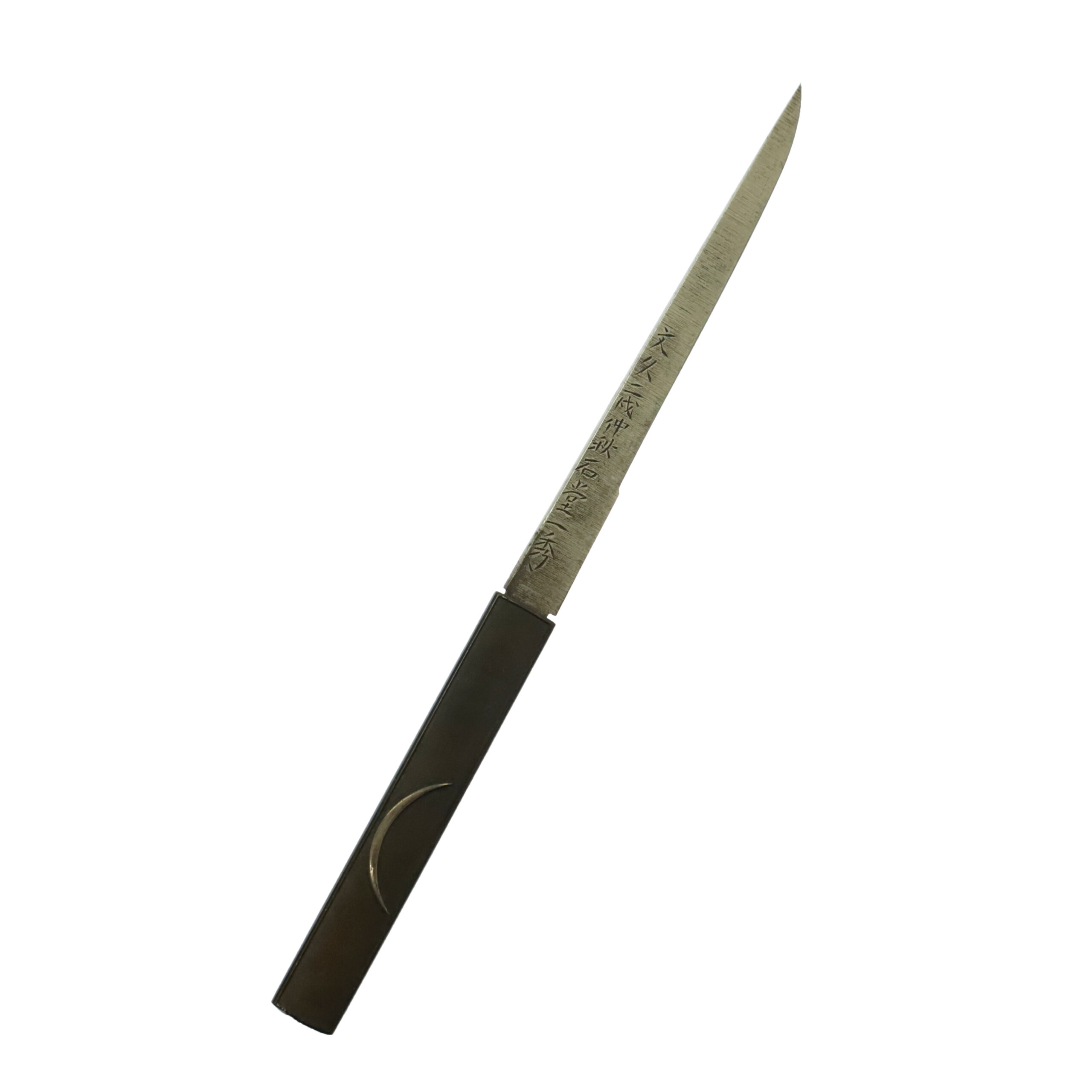

Saya: Saya is the scabbard for the Japanese sword.
The motif of this Saya is a dragon (龍:Ryu). You would find a dragon whose eyes and whiskers are golden. Initially, the dragon is an imaginary creature found in ancient Chinese traditions or myths. Furthermore, it is regarded as a symbolic beast of auspicious signs. Its body is likened to nine animals: antlers are deer, the head is a camel, eyes are demons, the neck is a snake, belly is Mizuchi (蛟, mythical animal in Japan which looks like a snake and have a horn and four legs), scales are fish, claws are falcons, palms are tigers, and ears are cows. It was thought that the dragon would reign at the top of all animals because of its odd-looking appearance.
In ancient China, the dragon pattern was used for emperors’ clothing so that people strictly defined its shape or even the number of nails. On the other hand, the dragon pattern does not have detailed rules to represent classes in Japan. However, still, it maintains its meaning as the all-purpose auspicious pattern.
Also, in Japan, there is a belief that worships dragon as a water god and is called Ryujin Shinkou (竜神信仰). Since rice cultivation flourished in this country, water is always an essential resource. Therefore, the dragon motif has been familiar to Japanese people since a long time ago.

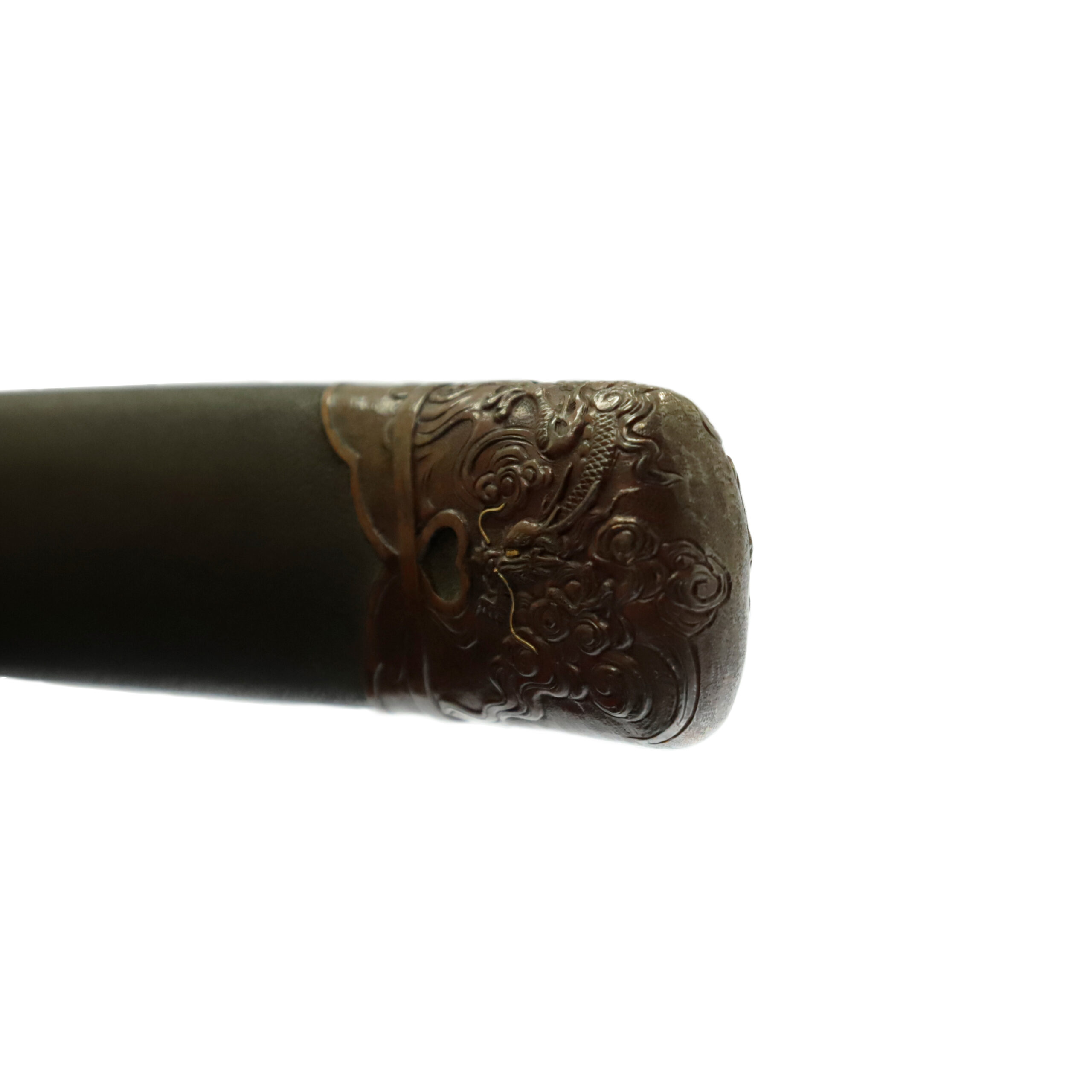
Authentication Paper:NBTHK Hozon Certificate for the blade (No. 3016782)
NBTHK, also known as Nihon Bijutsu Touken Hozon Kyokai (the Society for the Preservation of the Japan Art Sword), is one of the oldest Japanese sword appraising organizations in modern-day Japan. They authenticated the blade on Mar 15th in the 30th year of Heisei (2018). They appraised it as Hozon Touken, the blade worth preserving for Japanese society. The purchaser will receive this original certificate as well. We can also translate what is written into English and make a PDF file for your record if you request.
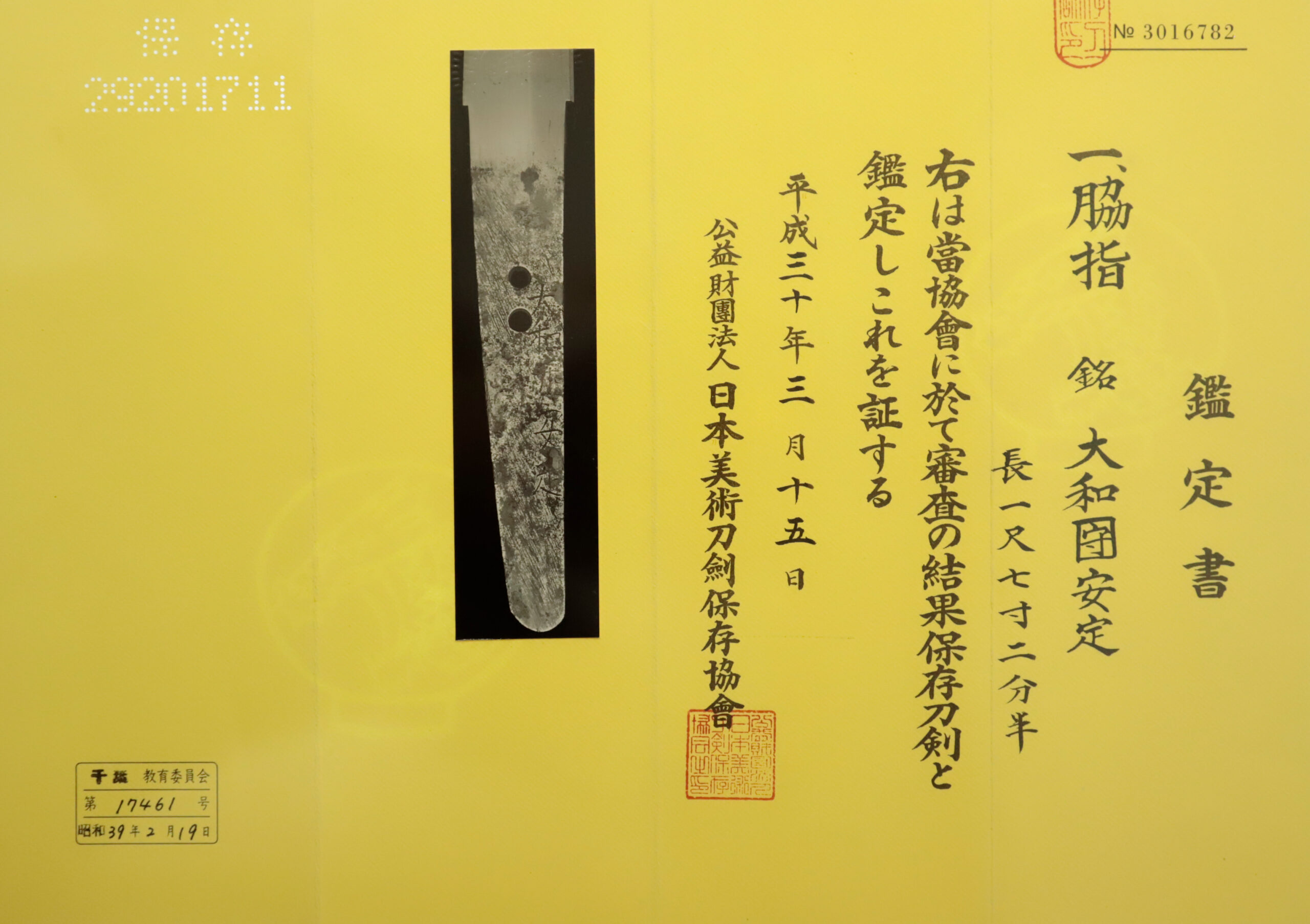
Registration Number : Chiba 17461
The Board of Education in Chiba prefecture issued a registration paper for this sword. It is called Jyu Token Rui Torokusho(銃刀剣類登録証). Bunkacho(The Agency for Cultural Affairs) acknowledges a Japanese sword with this paper as a work of art.
The sword needs to be traditionally hand-forged and made of Tamahagane carbon steel to be registered in the system. With this paper, its owner in Japan can legally own an authentic Japanese sword. Based on this registration number, we will apply for its export permit.
This paper will need to be returned to the board of education when the sword is being shipped abroad, but you can receive a copy of it. An English translation of this registration paper is available on request.
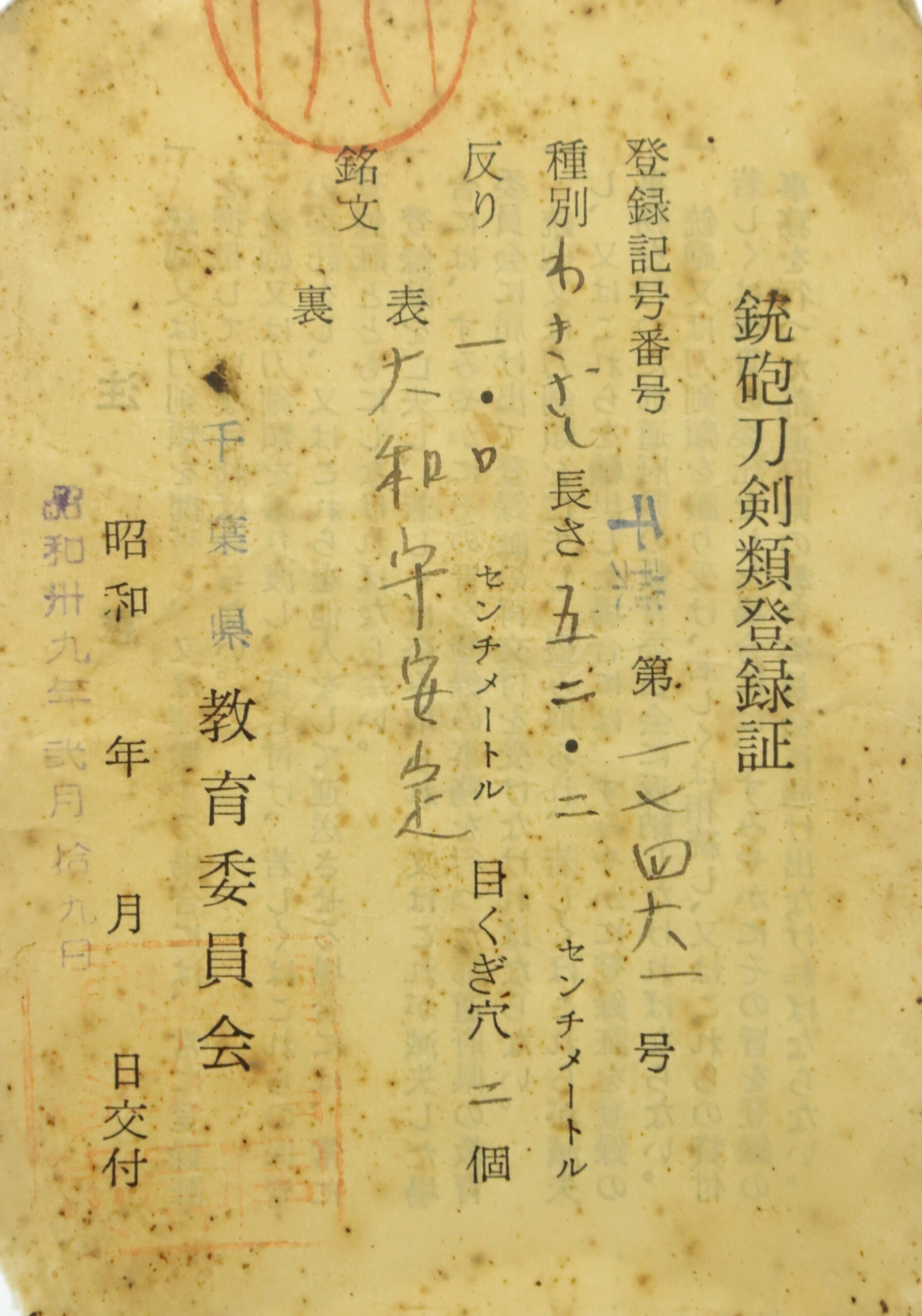
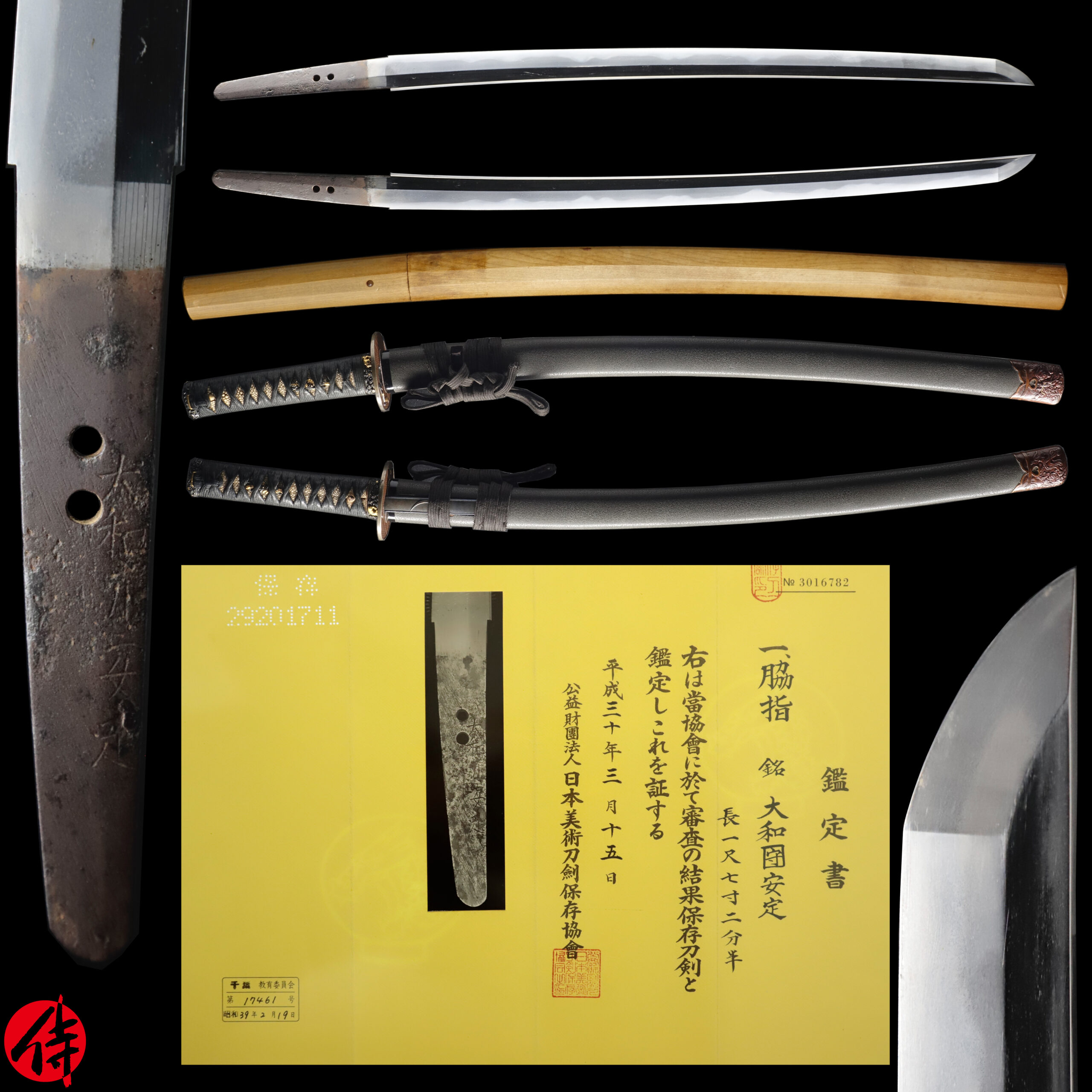
—————————————————————–
【About us】
Samurai Museum is located in Tokyo, Japan, exhibiting antique artifacts related to the Samurai history. Samurai Museum Shop is the place for those who are interested in Japanese culture and craftsmanship. We deal with antique Samurai swords/armor, traditional crafts made in Japan and so on.
【Japanese Sword& Export Process】
The Japanese swords we deal with are hand-forged edged swords made in Japan. It was made from the traditional carbon steel called TAMAHAGANE(玉鋼). Samurai Museum is familiar with the proper legal procedure for an antique/ authentic Japanese sword to be exported from Japan. We have sent more than 700 Japanese swords for the past few years (~2024) to amazing owners who appreciate its historical value.
Each Japanese sword is registered under the Agency for Cultural Affairs and the Board of Education in Japan. They issue a registration paper for each Japanese sword for its owner in Japan to legally possess it. The Japanese sword with its registration paper means it was traditionally hand-forged in Japan.
To legally export the sword from Japan to other countries, we will have to apply for its permit to the Agency for Cultural Affairs(Bunkacho) and return the original registration paper to the Board of Education. It normally takes around 2-4 weeks to receive this permit after submitting required documents. And we would like you to expect at least 1-1.5 months for your order to arrive at your given address after you ordered. For more detailed info, please click here.
It is allowed for residents in Japan to own authentic Japanese swords without a special license as long as they come with registration papers. Please feel free to contact us if you are a resident of Japan, whether temporarily or permanently. We will also assist you when you leave Japan and need to obtain the export permit.
【Payment Method】
We accept payment through Stripe (Credit card), PayPal, Apple Pay or ChromePay, all of which are secure payment methods. Also, you don’t need to make an account on Stripe for the checkout. If you prefer other payment method, please contact us. After confirming your payment, we will apply for an export permit. You may either pay in JPY, USD, AUD, CAD,EUR CHF or GBP. The price is set in Japanese Yen. Prices in other currencies are automatically calculated based on the latest exchange rate.

* If the amount is above 1 million JPY, Stripe or wire transfer will be the only options for payment.
【Shipping】
We have shipped authentic Japanese swords to the USA, Canada, Mexico, Germany , Belgium, France, Finland, Hong Kong, Australia. If you don’t live in these countries and like to order, please contact us first before making a purchase. We offer Free International Shipping as long as we can send antique Japanese swords by EMS.
We normally ship by EMS(Express Mail Service) provided by Japan Post. We will send you a tracking number for your order as soon as we hand it to the post office. We will put 100 % insurance on the shipping document without any extra charge. Based on the total amount, there might be a duty tax or other fee for you to pay, depending on the countries. We use package cushioning to protect the item and put it in a PVC pipe, which is one of the most secure packages because of its durability.
It will normally takes 5-14 days for the item to arrive at your given address after we dispatch it. Time of delivery is estimated as accurately as possible by the carrier but does not take into account any delays beyond our control such as by inclement weather, post office holiday seasons.
* If you live in Australia and like to purchase an authentic Japanese sword, please click here to know the detail.
* If you live in the UK and like to purchase an authentic Japanese sword, please contact us first and click here to know the detail.

【Review】
Here is one of the reviews we received from a customer who purchased an authentic Japanese sword from us. For more reviews, please click here.
“My experience overall with the whole process was wonderful. I had many questions about the history and process to purchase these treasures. All my questions were answered very timely and complete. The staff is very knowledgeable and very well versed if any questions do arise.”
【How to make sure the condition】
Please keep in mind that what you are going to purchase is an antique item. We uploaded high resolution photos for you to check its condition thoroughly. If you like to see more photos with different angles, please feel free to contact us. We will be happy to send them to you so that you can make informed decision. It is essential for us to know that you are happy with your choice of a sword. and we are prepared to use the best of our ability to serve you.
【How To Contact Us】
Please contact us through email, Facebook Messenger or Live Chat if you have any questions. You can find each icon on the right side of the website. Please click one of them to reach us. We will reply to you within 1-2 business days.
【The Art of Nihonto (Japanese Sword)】
Samurai’s history is a profound, eloquent legacy of ancient Japanese warriors in which millions of people worldwide are being fascinated. If you like to find out the art of Nihonto, please click here.
【A Guide to Japanese Sword Maintenance】
After acquiring an genuine Japanese sword, it is also important to know how to take good care of it. Here is the special video for you. Mr. Paul Martin, Japanese sword expert, shows you how to give proper maintenance to your sword. By mastering how to clean the Japanese sword, its aesthetic beauty will last forever.
When you purchase a Japanese sword from us, you can get a Free Japanese sword maintenance kit. It comes with four tools(Choji Oil, Uchiko Whetstone Powder, Peg remover, Oil Applicator). By watching the video instruction above , you can enjoy learning how to maintain your Japanese sword while appreciating it. If you have any difficulty assembling the sword or cleaning the blade, you can feel free to contact us.
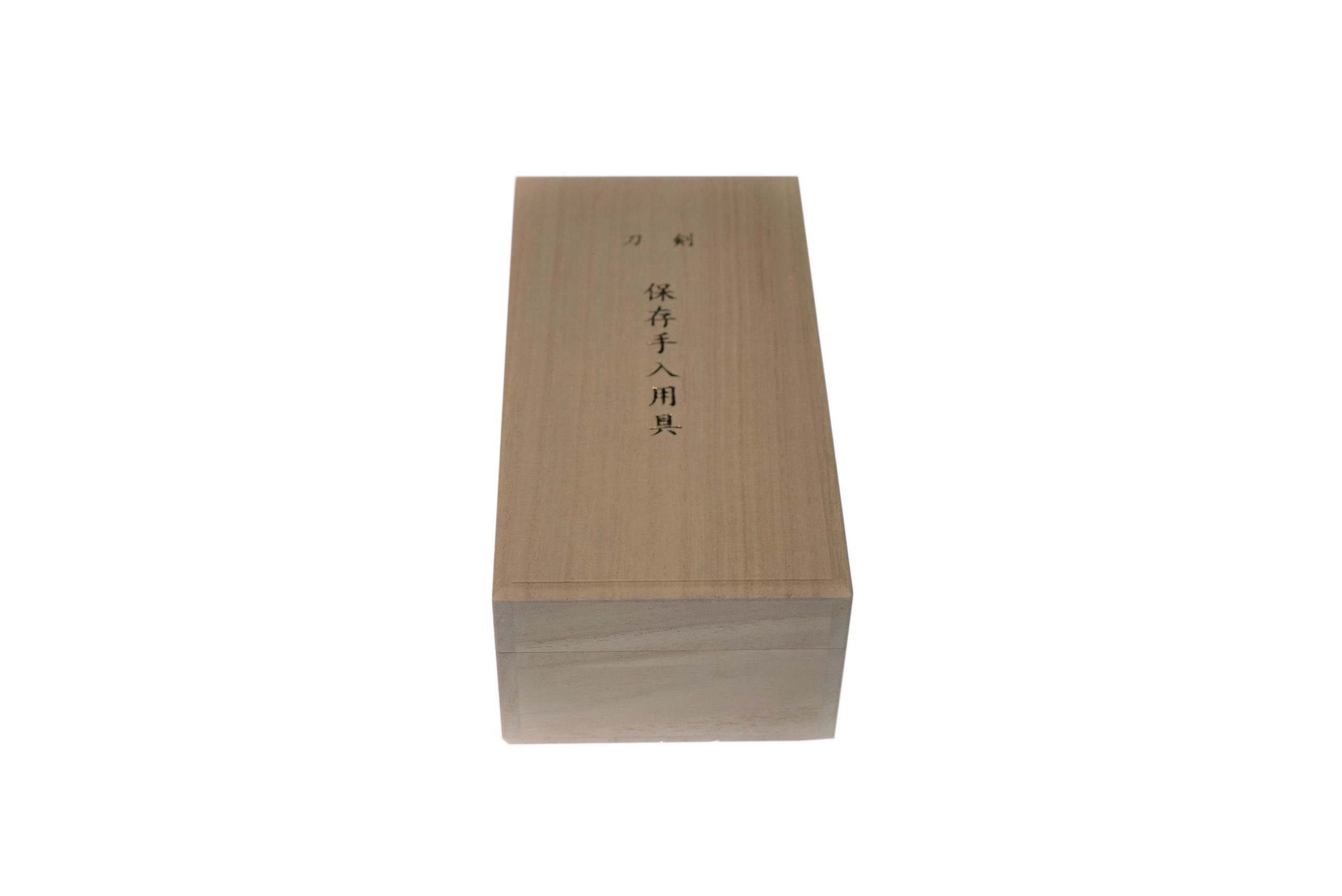
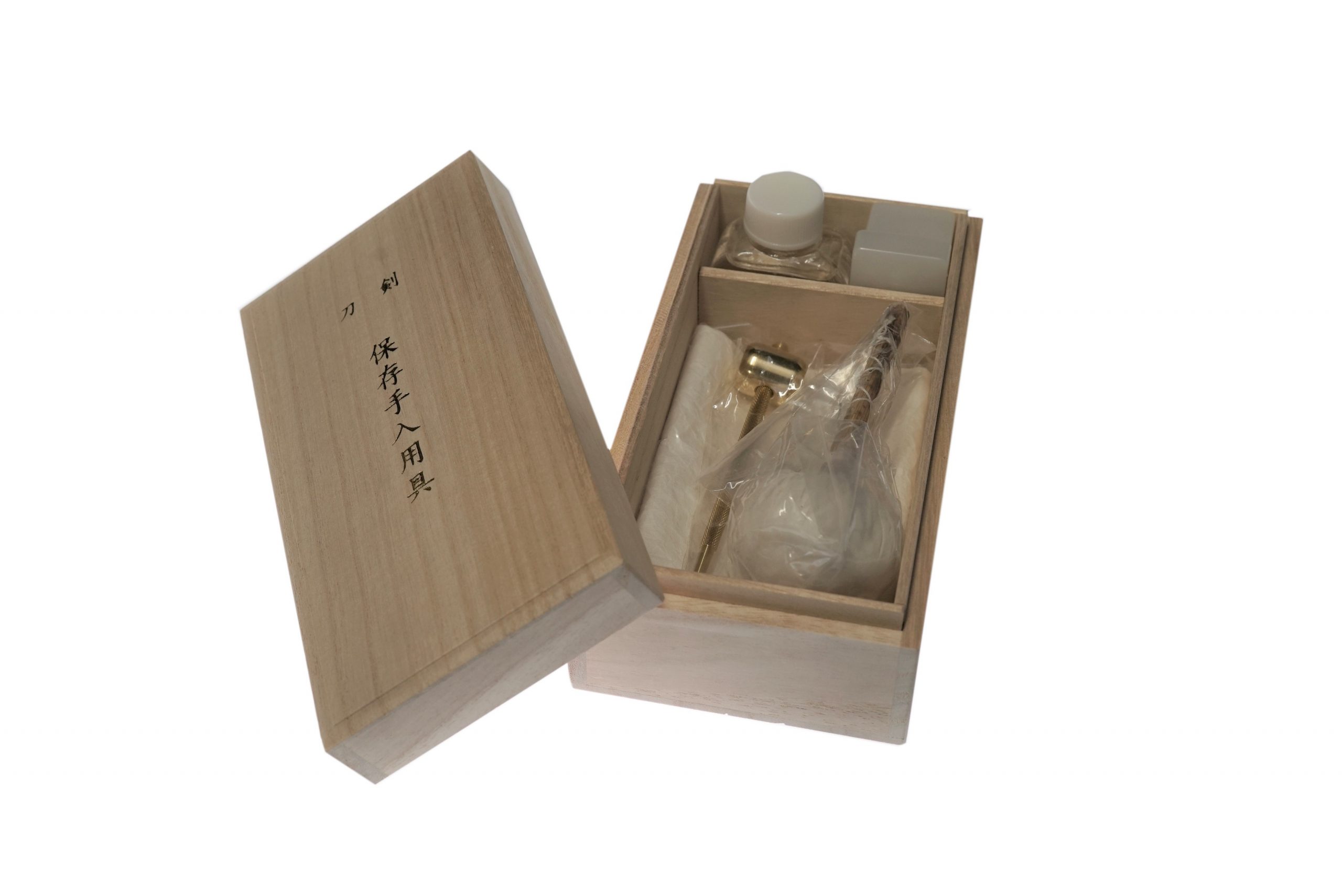
MORE ANTIQUE JAPANESE SWORD FOR SALE
SWORDS WITHOUT CERTIFICATES FOR SALE
LEARN JAPANESE SWORD TERMINOLOGY
Thank you for reading all the information on the page. If you have any difficulty choosing the right Japanese sword for you, we will be more than happy to help you find the one that speaks to you the most. Please feel free to contact us.
